The history of the study of the brain from ancient Egypt to the beginning of the XX century
The first mention of observations of the human brain, or rather, changes in human behavior under the influence of the poppy, the Oxford Handbook of Psychiatry on 26 pages refers to the Sumerian records of 4000 BC. e. Archaeologists say that at about the same time, maybe a thousand years later, the first brain operations, known to us as trepanation , were related .

It is difficult to say how successful such surgical interventions were, but it is from this time, as it is believed, that the study of the human brain, psychology, neurology originates. Inside, as usual, there are many surnames, dates, links to the main discoveries and pictures of the human brain: Europe and the East, from Papyrus Edwin Smith to lucid dreams.
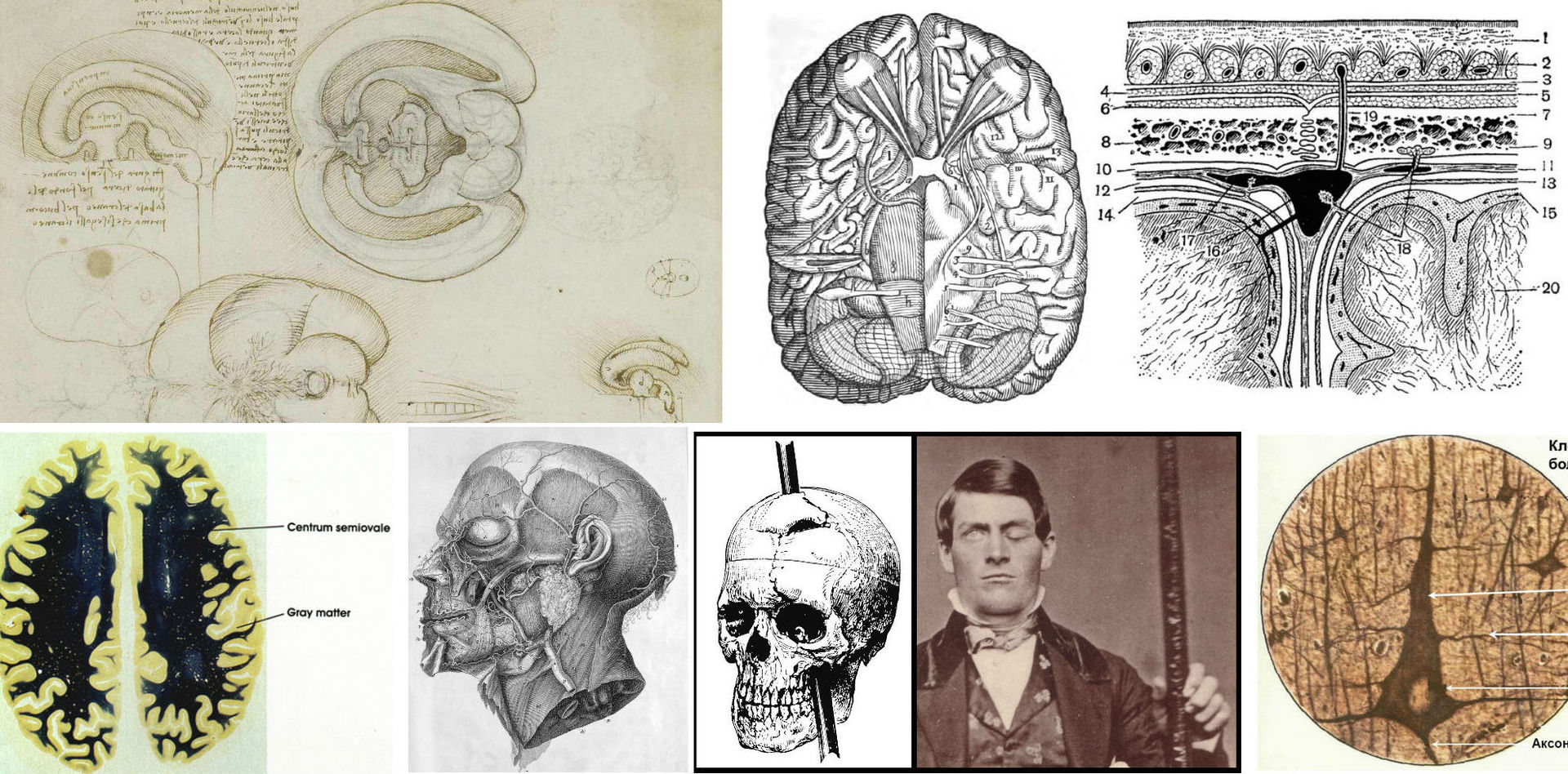
Ancient Chinese medicine is associated with a semi-mythical name - Shen Nong , who, in addition to determining a long-term herbal treatment, and according to legend, he “tested” them several times a day and self-poisoned, also warned the development of acupuncture, or acupuncture, which and to this day is common in China. The invention of reflexology dates back to approximately 2,700 BC, and today it is an intangible heritage of UNESCO .
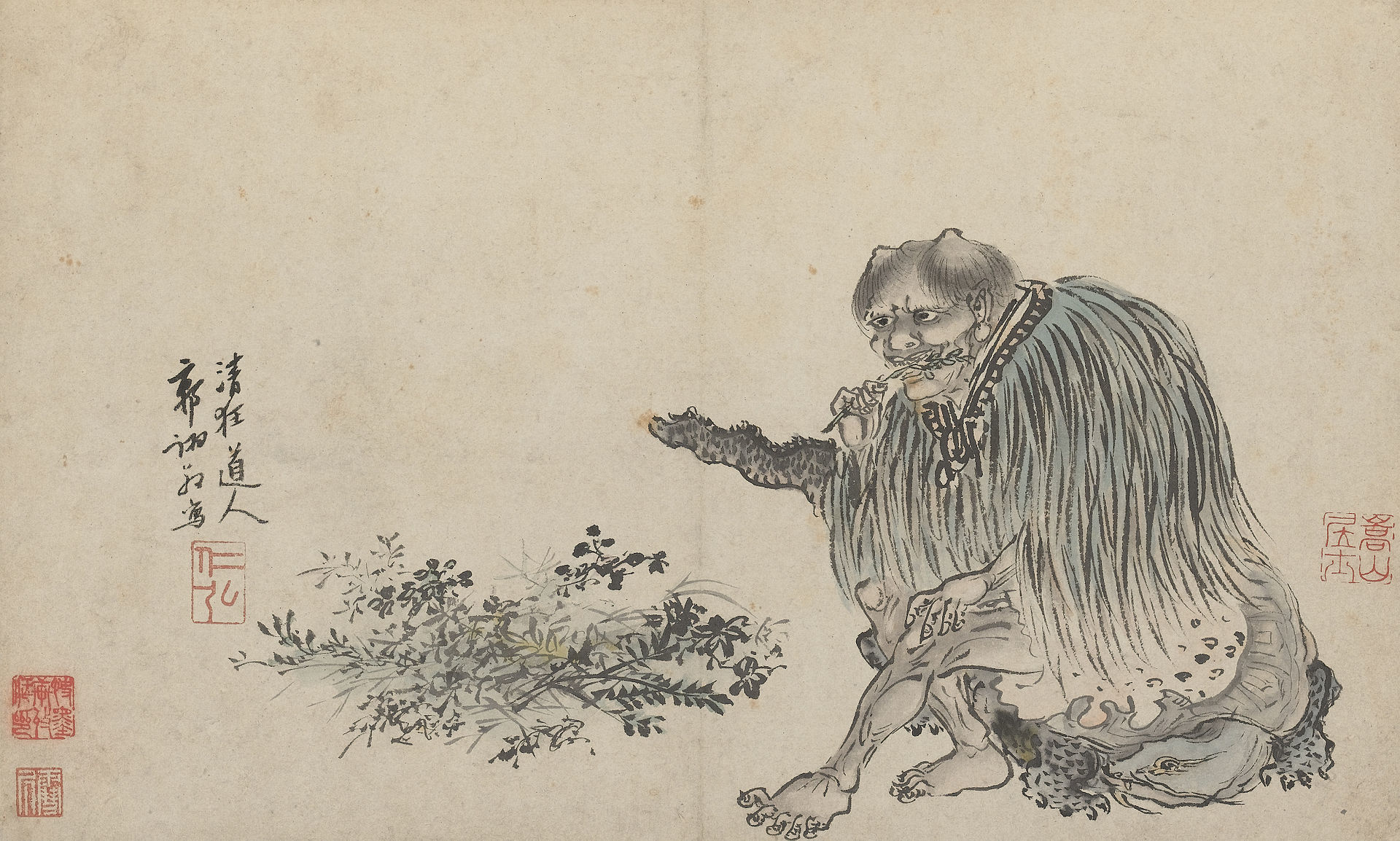
Controversial Ancient Egypt. And this is not surprising in a country where medicine and science very closely coexisted with religion. On the one hand, the attitude to the brain was quite “cool,” and after death it was pulled out and frankly thrown out. Since the heart was considered the "central" organ, there are indications of this in "Ancient Egyptian Book of the Dead . "The heart is the key to the afterlife after weighing on the scales of good and evil.
On the other hand, the Edwin Smith Papyrus , named for the collector who bought the paper in 1862, is widely known . It was allegedly recorded in about 1,700 - 1,600 BC. At the moment, this is one of the main texts of ancient medical literature, in which a sufficient amount of information is devoted to head injuries, intracranial pulsations, interspersed, of course, with traditional spells against the plague, etc.
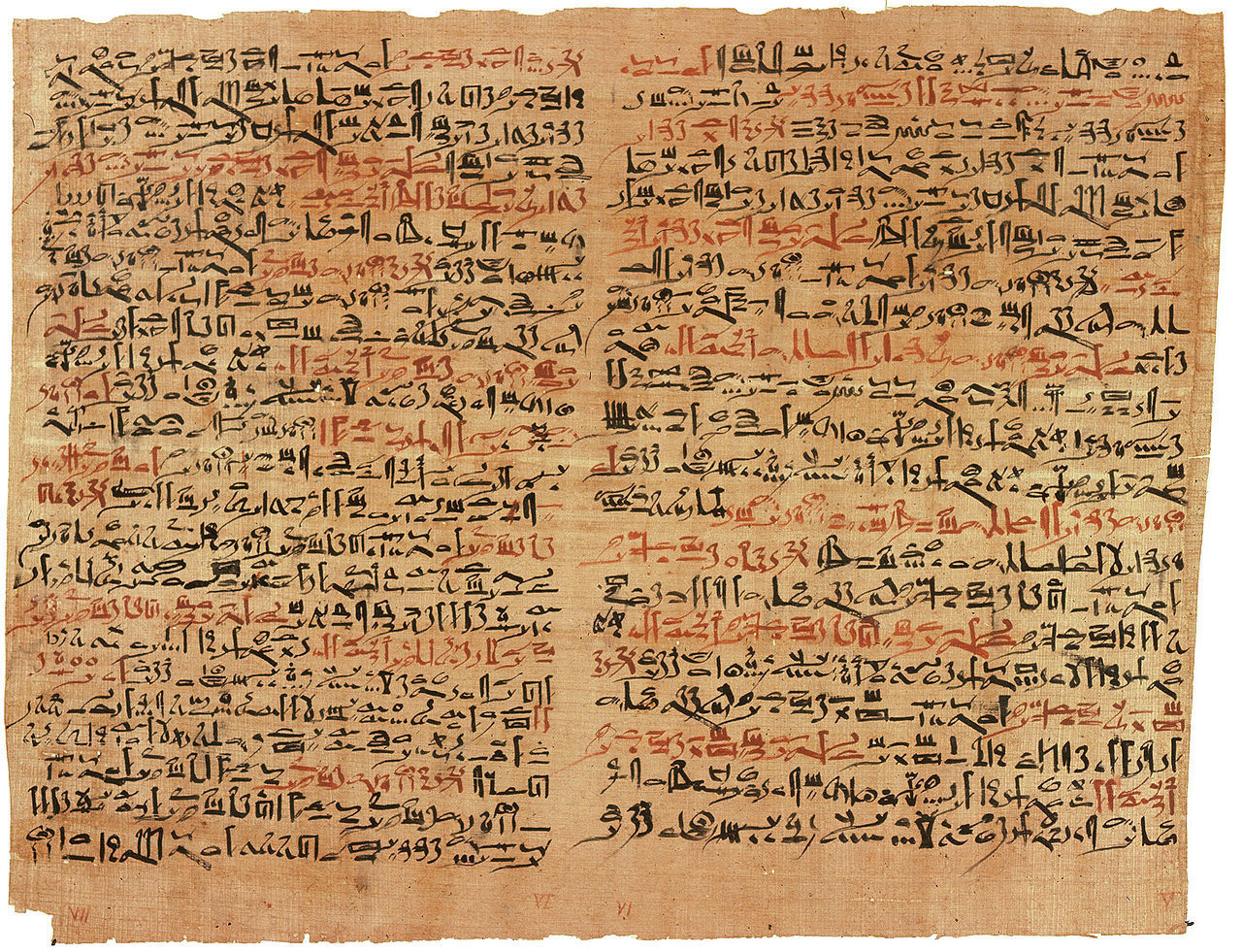
In total, on paper, the oral sources of which date from almost 3,000 to 2,500 BC. e. 48 “stories” are given, most of which relate to neurology, including open head and brain injuries. The first descriptions of cranial sutures, meninges and cerebrospinal fluids came with this document . The authorship is attributed to the founder of ancient Egyptian medicine, Imhotep , a very versatile person who served under Pharaoh Joser as an architect, and then went into medicine.

Hieroglyph “Brain”, approx. 1 700 BC e.
In parallel with this, approx. 2,000 BC e., scientists believe, in South America they continue to practice craniotomy as the prevention of headaches and mental illness, epilepsy. Moreover, a significant number of “opened” skulls indicates a systematic use of this “technology”.
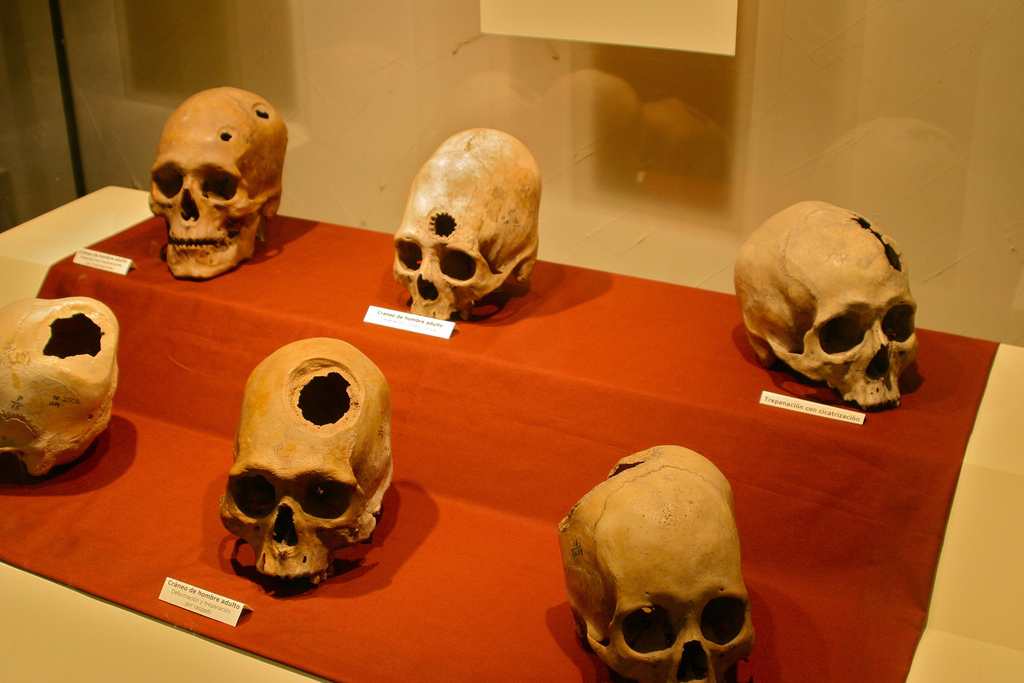
Bronze “wedges” with sharp edges, presumably of volcanic rock, were used as a surgical instrument. However!
Some historians and archaeologists prefer to associate these prehistoric holes in their heads mostly with religion, since the first mention of epilepsy dates back to a much later time and a slightly different culture. Ancient Indian medicine, which began in Atharva Veda, gave the world approx. 6th century BC e. Sushruta Samhita is one of the main books of Ayurveda , where the foundations of surgery are laid.
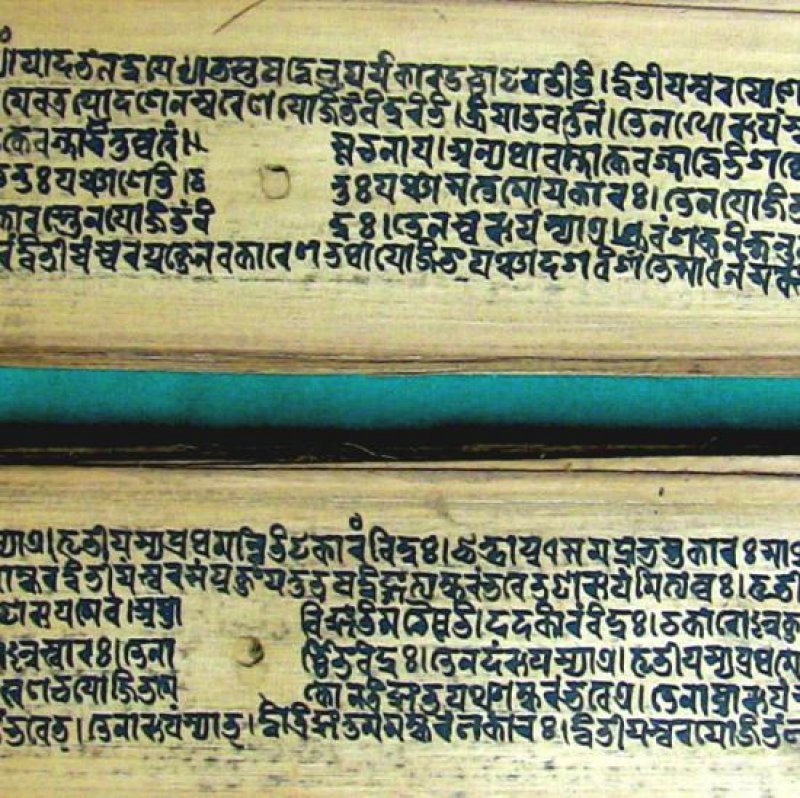
One of the parts - Uttara - is dedicated to minor surgery, the so-called "shalakye", or surgery "above the shoulders", which provides descriptions and examples of ophthalmic diseases, including vascular diseases, and also refers to the removal of cataracts. An outfit with this text, the second most important treatise on medicine of that period - Charaka Samhita describes the mental disorders of people, considers epilepsy, its symptoms and treatment methods. Ayurveda books .
Hippocrates adhered to a similar point of view that epilepsy is a disease, not a divine punishment. The ancient Greek physician has a significant role in medical science, in particular the science of the brain, and it is he who is credited with the idea that the brain, the mind, originates in the brain. However, a century earlier , Alkmeon , a philosopher who was not mentioned anywhere, however, as a medical practitioner could have expressed the same idea . Despite this, he is credited with the discovery that the brain, and not the heart, is a key organ for a person that determines his life and destiny.
Other philosophers and theorists, however, quite great, also expressed hypotheses regarding the human brain, and Plato believed that the brain was the birthplace of all mental processes, and Aristotle, carried away by the science of sleep, assigned this role to the soul and heart. One way or another, without serious practice, studying the brain was impossible. A key legendary figure in ancient Greece was Erasiastes , a practicing physician, anatomist who described not only the brain departments and functions of the cerebellum, but also left at that time the only detailed description of the human circulatory system.
Erasiast works in tandem with the “Father of Anatomy” Herophilus , who clearly differentiated the brain and cerebellum, suggesting the functions of each. According to Herophilus, it is in the cerebellum that the “nucleation” of intelligence takes place.
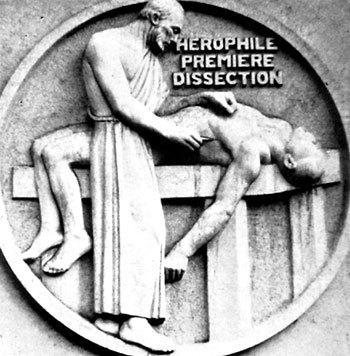
Herophilus
Scientists steadily anatomize corpses, leaving us with detailed reports on the structure of the brain and heart, as well as a detailed description of the circulatory system. In the yard 335 - 280 BC, and these are the last major discoveries concerning the human brain for that period.

Cerebellum - Red
Roman Classics
Around the 177th year the work on the brain of the outstanding Roman surgeon Galen dates . His research included physiology, pharmacology, neurology, surgery, and many of the discoveries were confirmed during the Renaissance and today.
He owns the theory that since the cerebellum is harder relative to the brain, it is responsible for the muscles, and the brain itself - since it is softer - for the senses. He assigned the place of “one of the three souls” to the brain, and saw its origin in semen, as the substance was cold and wet.
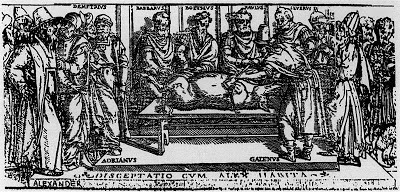
It should be noted that since Roman law at the time of Galen’s activity prohibited the autopsy, most of his experiments took place on pigs and primates. Thanks to this, his descriptions of the trachea, circulatory system, which turned out to be very close to the human, appeared. Galen also owns the theory of "Body Juices" about human temperaments, or rather, their dependence on the amount of blood, bile and black bile and phlegm.
As in Ancient Greece, in Rome there was no shortage of philosophers, and one of them, Nemesia in workAbout 390, Nature of Man tries to describe the human body, taking into account already Christian traditions. He was not a doctor, but he assumed that various parts of the brain are responsible for various functions, and here, according to scientists, his task was not to describe the structure of the human brain, but to reconcile pre-Christian Platonic philosophy with the philosophy of modern times.
Medicine is also developing in the East, where translations including Greek books penetrate. One of the central monuments of medical literature is the Comprehensive Book on Medicine , the author of which, Abu Bakr Muhammad ibn Zakaria ar-Razi , was known both as a musician and as an artist, and by the age of 30 he became a passionate physician, leaving a legacy of his works in chemistry, pharmacology, medicine.

He first spoke of cranial nerves when he observed symptoms of meningitis, among which patients experienced severe dull headaches.
The second part of the book of Razi was devoted to eye diseases, and on the basis of this work, a century later, about 1,000 years, the works of Ammar ibn Ali Mosul, Alzachen and other prominent Islamic ophthalmologists of the Middle Ages appear .
In Europe, by this time, not the most successful times for brain research were coming, and for some medical manipulations one could easily be at the stake due to the church’s prohibitions on desecrating bodies. There are scammers who adapted to the emerging legends of the “Stone of Madness”, which allegedly provoked all mental disorders, and began to offer their services to “extract” this misfortune, which was widely reflected in the then and later painting.
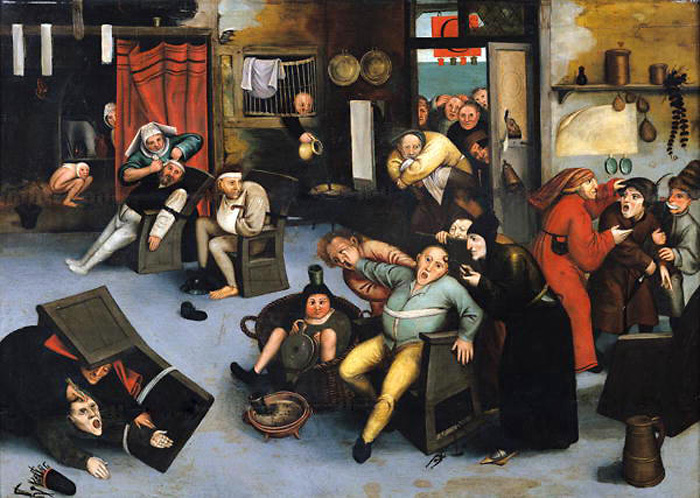
Bruegel the Elder
One of the exceptions of the time is the Italian professor of medicine - Mondino de Lucci. The surgeon and the anatomist overcame church prohibitions and devoted much effort to returning the autopsy to the medical program, and in 1395 arranged a public sanction authorized by the Vatican.
The scientist insisted that man is a higher being, and the study of the structural features of his body is unacceptable on the example of animals, which ultimately "poured out" into the first professional anatomical text - "Anothomia", which gives a theory of brain bubbles . De Lucci believes that the three parts of the brain - the bubbles - give a person their abilities: the front - feelings, the middle - fantasies, the back - memory.

Dissection of the skull of de Lucci
Frankly speaking, de Lucci did not open the corpses very often, and most of his remarks were gleaned from the works of Galen, and the works themselves are an attempt to adapt to the European culture, which has experienced several centuries of overt decline, the work of Avicenna. Nevertheless, a new round of development of European medicine is associated with the name de Lucci. And European medicine continued to worry about diseases of the brain and psyche, as evidenced by the opening hospitals for the mentally ill. One of them is the one that has given us the common name Bedlam : the Bethlehem Royal Hospital.
Renaissance
The period of an unprecedented cultural upsurge in Europe has affected all spheres of human life from art to medicine. In 1,499 published by Johann Peyligk, where he possibly refers to an earlier work - Compendium philosophiae naturalis and examines the feelings and moods of man, which still borders on philosophy.

The primitive anatomy of Johann Peyligk
Anatomy is also devoted to some essays by Leonardo da Vinci, in particular the sketches of the ventricles, which in many respects corresponded to the descriptions of Galen.

The revolution in practical anatomy was made by Vesalius and his textbook Tabulae Anatomicae 1,538. The founder of “scientific” anatomy first sharply criticized Galen, who anatomized animals, and corrected over two hundred errors in the works of ancient physicians. In particular, he was ironic about the idea that “higher” brain functions are located in the ventricles, since the ventricles are also observed in animals, which means they cannot be responsible for emotions and feelings, as was supposed a long time before.
In 1,543, he published his main book, On the Structure of the Human Body , which is richly illustrated. It describes in detail the structure of the human brain, meninges, nerves, pituitary gland (in the terminology of Vesalius - glandula pituitaria).
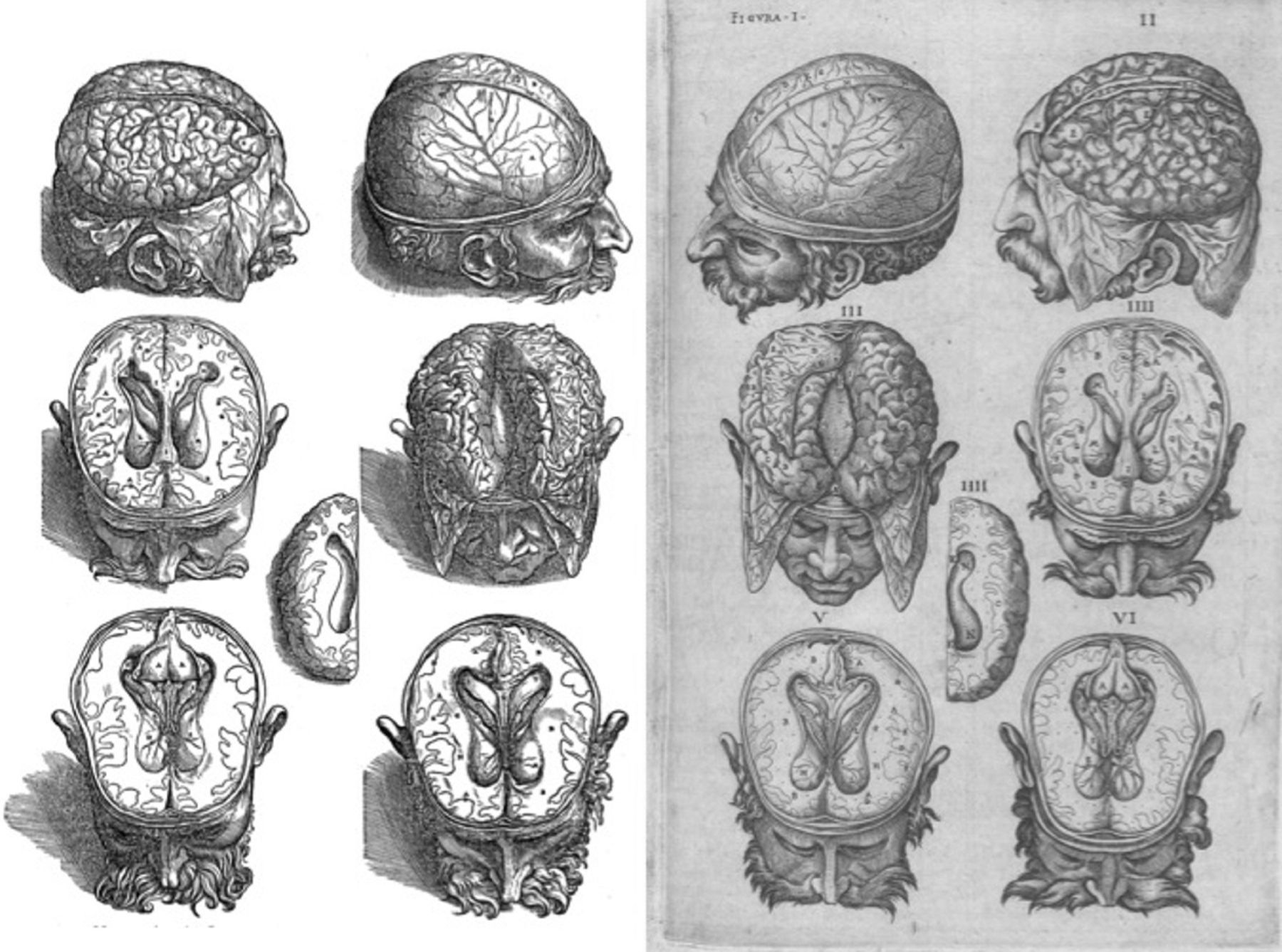
A few years later, Vesalius for the first time will pay attention tohydrocephalus , dropsy of the brain, and describe its symptoms. According to legend, the inquisition will condemn the innovator of medicine to execution, and only the intercession of the king will save him, and then only half: Vesalius will be sent to exile, or a pilgrimage, from where he will not return.
In 1,549, a book by Jason Pratensis appeared on brain diseases and their symptoms, where he continues to develop Galen's work on the brain being “responsible” for motor functions. In his book De Cerebri Morbis, he describes tremors, tetanus, migraines, epilepsy, and also summarizes the experience of ancient and Arab authors regarding treatment. Despite the "secondary nature" of this text, some consider the first complete description of known brain diseases.
At the same time, Bratolomeo Eustachio, an antagonist of Vesalius, best known for his Eustachian tube, the part of the ear named in his honor, works. He owns many discoveries related to hearing, but his main book , published almost 200 years after his death, presents him as an outstanding anatomist. In the book, he left detailed descriptions of human organs, their sizes and locations, as they say, from head to toe.
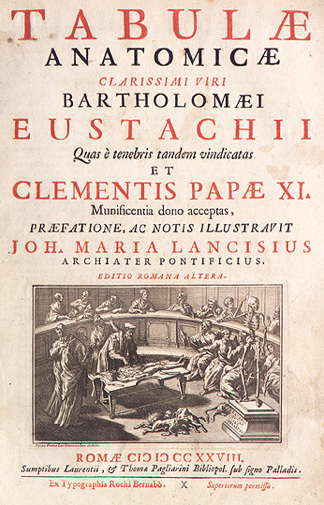
His discoveries around the inner ear and middle ear, as well as his connection with the throat, determined not only the medical future. According to legend, it was the work of Eustachio that prompted one of the plot twists of Hamlet: poison that was poured into the ear of the father of the Danish prince.

Detailed engravings were prepared for the book, which saw the light after the death of the author, and one of them - XVIII - shows in sufficient detail the base of the brain and the division into the sympathetic and parasympathetic sections.
In 1,561, Gabriel Fallopio lists some cranial nerves, describes parts of the ear, and for the most part his anatomical works are devoted to the ear and skull, however, the uterine or fallopian tubes are named after him .
The discovery of the hippocampus in 1,564 belongs to the prominent Italian anatomist Giulio Cesare Aranzi (1,530 - 1,589), and this part of the limbic system of the brain has been called so since those times. The hippocampus is a paired structure located in the temporal sections and is responsible for the formation of emotions and long-term memory.
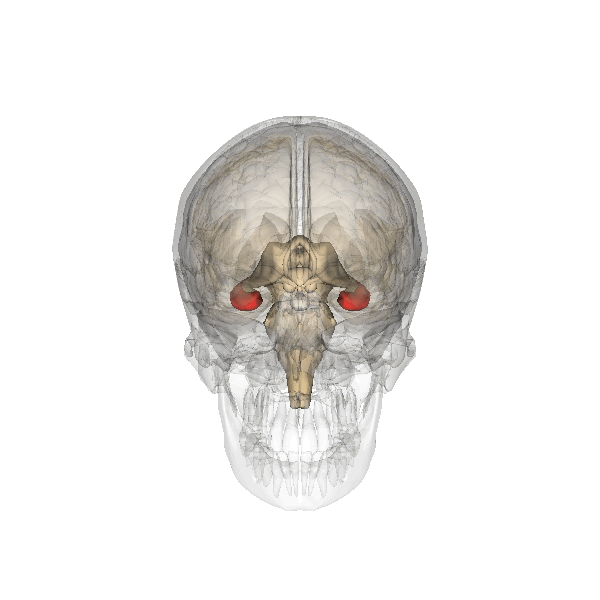
Aranzi’s student, Costanzo Varoly entered the history of medicine as the first who accurately described the mechanism of erection, and also introduced a new method of dissecting the brain, making it possible to examine it from the base. In the process of his work, he discovered in 1,573 a part of the hindbrain along with the cerebellum, which is responsible for the transfer of information from the spinal cord to the brain. This part of the brain now bears the name of the author - Varoliev Bridge .
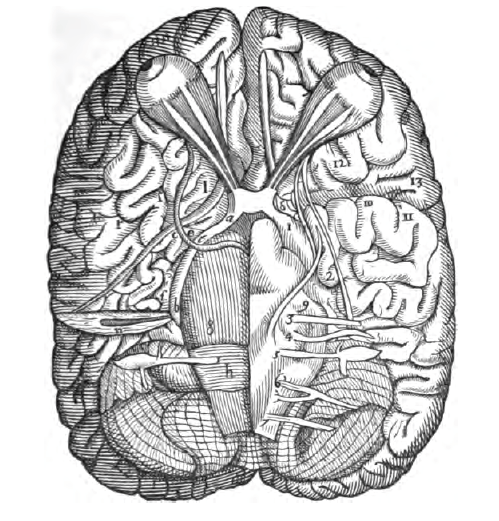
De Nervis Opticis, Varolia the
16th century is coming to an end , and the last big name is Felix Platter , the founder of forensic medicine, who devoted a lot of time to the study of mental disorders. He belongs to the first classification of mental disorders, a description of psychoses andobsessive-compulsive disorder . I noticed and described intracranial tumors, in particular benign meningioma .
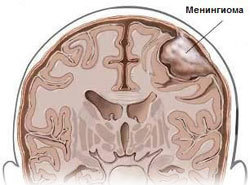
In 1 609, Giulio Casserio identifies the mammary bodies of the hypothalamus , located in the back, which are responsible for some behavioral factors. And at the same time, Robert Burton, a priest, philosopher and poet, writes The Anatomy of Melancholy , a prosaic book about depression. And I must say, if very rude, then starting from the 17th century, what the brain consists of and what happens in it, in simple terms, began to fall into “neurology”: in other words, everything that is connected with the head directly or indirectly.
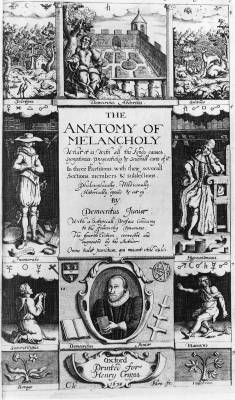
1 641 years. The name of Francis Sylvia is associated with the discovery of the lateral groove of the brain, one of the deepest, which separates the temporal part from the parietal and frontal. And although for the first time in the drawings she was captured earlier, and the first who spoke about her - Caspar Bartolin - died by this time, it is Silvius who gives a detailed description.

Almost in the middle of the century, the central place in the brain - the Epiphysis, or pineal gland, attracted the attention of the philosopher Rene Descartes and gave her a place, "where the soul and all our thoughts originate." To date, the functions of the pineal gland are not fully understood , and the main ones include inhibition of growth hormones, inhibition of sexual development and the effect on sexual desire in general. Also, the thyroid gland is responsible for the production of melatonin.

The pineal gland in the illustration of Descartes
In 1 658, Johann Jacob Wepfer describes cerebrovascular disease and for the first time talks about what a stroke is and describes its symptoms and causes. His treatise on this is called Historiae apoplecticorum , and he is digitized.
One of the most important figures in the science of this century is Thomas Willis, who coined the term “Neurology”. He owns a number of important discoveries, in particular, the division of diabetes into “sweet as honey,” sugar and non-sugar, since he first drew attention to the taste of urine.
For the first time, it was he who numbered the cranial nerves, and this order is still used in clinical practice, and the Willis circle was also named after Willis- arterial circle at the base of the brain. A special role in his work was assigned to brain diseases, and Willis first spoke about the causes of epilepsy, convulsive diseases.

The Willis circle provides sufficient blood supply to the brain if there is a blockage of any vessels, and it is absolutely normally developed that it occurs only in 50% of cases. Most vascular aneurysms originate here.
In 1,664, the Dutch physician Gerard Vlasius discovered and described the arachnoid, or arachnoid membrane of the brain. This is one of three membranes, the middle one, covered on both sides by glial cells , which make up up to 40% of the central nervous system.
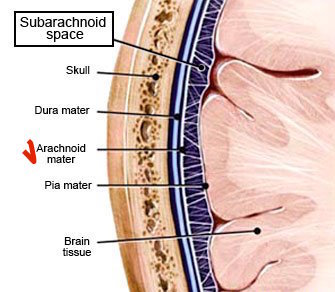
After 6 years, William Molins supplements the “picture” of the cranial nerves with a block, the deviation in which causes diplopia , or double vision.
Toward the close of the 17th century, several interesting studies appear at once. Some of them belong to the anatomist Raymond Wiessessens , who, inheriting the Willis tradition, gave a number of accurate, comprehensive descriptions of many modern ailments. The Semi-Oval Center is named after him - the white matter of the brain, which is located in each hemisphere and is located under the gray matter.
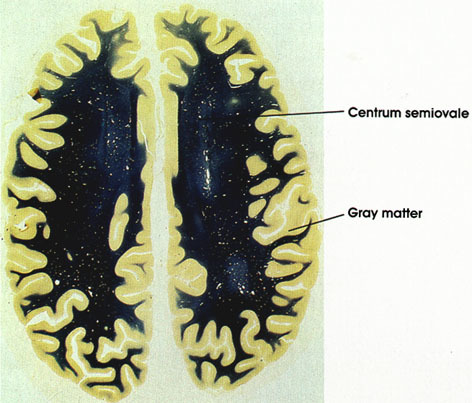
in 1 686, Thomas Sydenham , who owns the classic descriptions of many diseases, opens the choreaand describes her symptoms, indicating that her causes may be hidden in the brain. Later it became clear that in all cases of the disease, the basal nuclei located in the central white matter are affected . Chorea syndrome is accompanied by fanciful uncontrolled movements and can be either hereditary or acquired.
The rope-like body is opened by Humphrey Ridley , who is little known today , who left, however, many important notes. He practiced on hanged criminals, and was able to offer many new comments about the structure of the brain, the lymphatic system, even before Schlemm called the venous sinus of the sclera and made a description of the sarcoma. His main book was “Brain Anatomy”, where he first described the subarachnoid, or subarachnoid tanks (part of the structuresubarachnoid membrane ) filled with cerebral fluid. He also owns the discovery of the blood-brain barrier and the fifth cranial nerve.
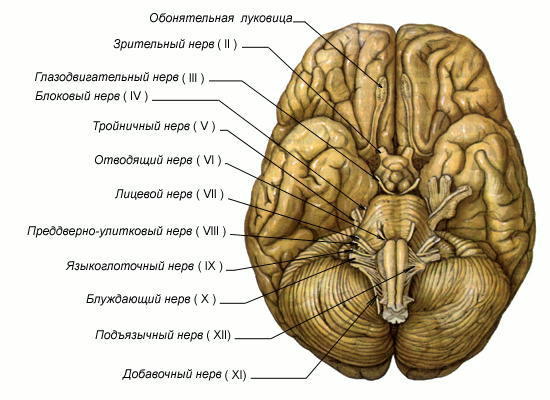
And the 17th century ends philosophically - "The Experience of Human Understanding " by John Locke, where he discusses the theory of knowledge and the capabilities of the brain.

Neurology could not move on without equipment, and the time for anatomical discoveries that could be made with the naked eye passed. This was understandable in the middle of the past century, when thanks to Hooke , an optical microscope was improved .
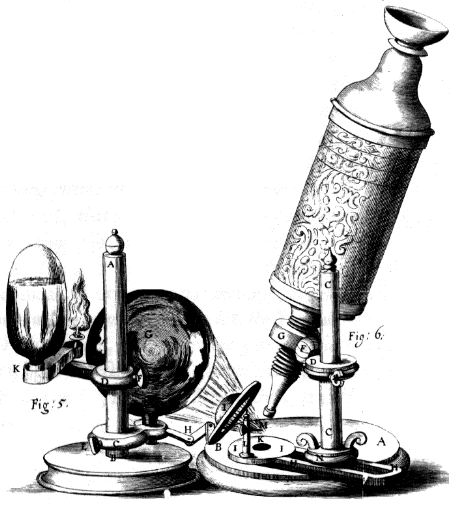
Largely thanks to his discoveries of cells (in fact, the term “cell” itself belongs to Hook), science moved on. At the beginning of the 18th century, Antonio Pacquioni discovered Pacquion Granulation (named after him), focusing his research around the arachnoid membrane of the brain. And although today the functions of Pacquion granulations are not completely clear, the main hypothesis is based on the fact that they contribute to the outflow of cerebrospinal fluid into the venous channels of hard tissues and normalize in the hard shell of the brain.

Pakkionovskie granulation - 18
Despite the fact that the vast majority of the discoveries of Anthony van Levenguk were outside the scope of neurology and the 18th century, in 1 717 he describes nerve fibers. However, the contribution to the science of Levenguk, one of the founders of scientific micrography, inspired by his contemporary Robert Hook, is already huge, and E.-T.-A. Gofaman even made him the hero of one of his works.
In the same century, in one of David Gartley's books, the word "psychology" was first heard. In “Reflections on a Man, His Structure, His Duty, and Hopes,” the second part is devoted to theological issues, and in the first, Gartley discusses the nervous system of a person. But the scientist went down in history as a theorist of such a trend as associationism .
With the development of technology, the search begins for methods of treating various diseases. For example, the famous physicist, whose experiments with electricity served as the basis for subsequent discoveries, Jean-Baptiste le Roy , proposed to treat mental illness with the help of current, and conducted the first experiments in 1,755.
Impressive statements about the functions of the cerebellum in the year 1760 are made by Charles Lorry , noting that damage to this part of the brain destroys the coordination of movements, and also indicated which neck vertebrae need to be punctured so that death occurs instantly.
Largest Italian scientist Domenico Cutugno, who owns a number of discoveries in otolaryngology and neurology, notes the connection between the cerebrospinal fluid and the ventricles of the brain, however, it was done, it was apparently “like”, as the main work of the physician was turned to the back, and the discovery of some cerebrospinal fluid is attributed his. He also left a detailed description of the sciatic nerve.

At the same time, one of the representatives of the medical dynasty Alexander Monroe II was working , who would later describe the interventricular foramen, or the “ Monroe foramen ”, when closed, hydrocephalus may develop. It also provides normal circulation of cerebrospinal (cerebrospinal) fluid.
A detailed scientific description of cerebrospinal fluid in 1,766 will be left by Albrecht von Haller. His research in the field of the nervous and muscle systems allowed him to prove the reactions of the brain to various effects on the muscles, and he also demonstrated that when certain parts of the brain are removed, these reactions stop.
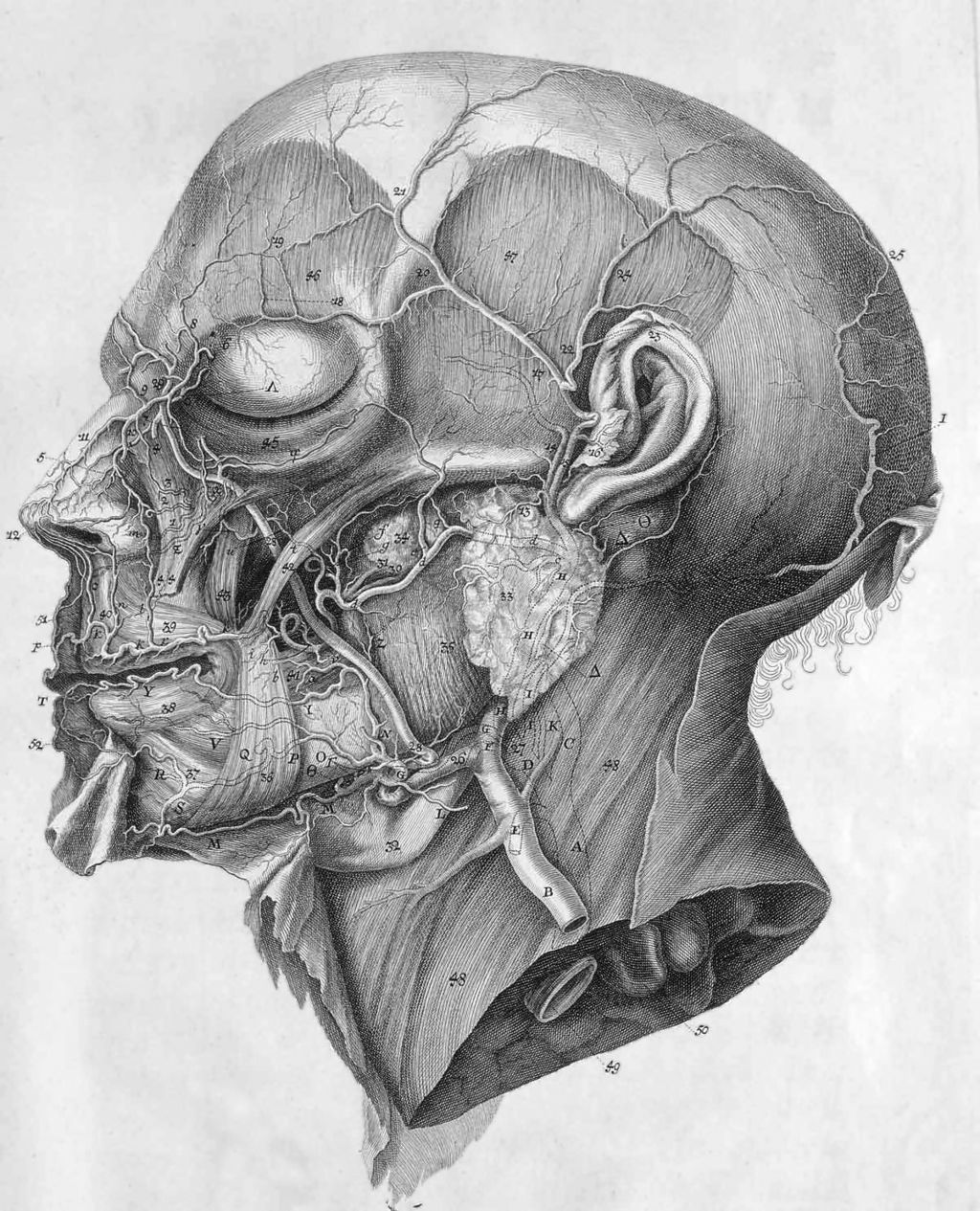
Haller. Icones anatomicae
In 1 773, the English physician John Fothergill describes the neuralgia of the triple nerve , which has long been called by his name. The disease is quite common and very painful, accompanied by wild shooting pains that relieve antiepileptic drugs or bone blockade.
Remedies for the human brain, chemical or “psychological,” also opened in the 18th century. In 1,773, Joseph Priestley discovered the “laughing gas," or nitric oxide, which is used as an inhalation anesthesia, and in 1774, Mesmer discovered "animal magnetism", a form of hypnosis that is not currently used in medicine.

In 1,776, Vincenzo Malacarne was engaged in research on the cerebellum and central nervous system, which determined the direction of research of many future classics of neurology. He was the first to fully describe the cerebellum anatomy correctly.
Malacarne is not the only one who generalizes and improves the experience of his predecessors. So, two years later, Samuel Thomas Semmering describes the classification of 12 cranial nerves, which is still relevant . The scientist at that time was 23 years old, and the classification became part of his thesis.
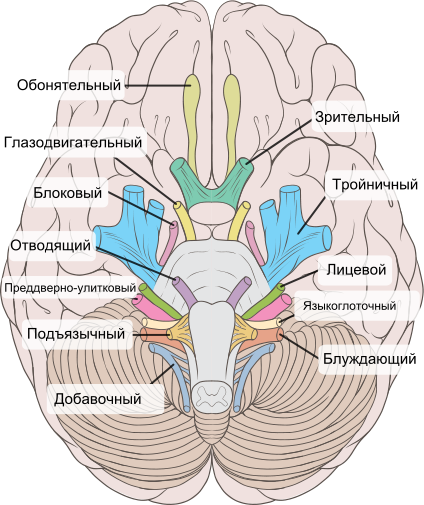
He will later describea retinal yellow spot , the studies of which are also “shared” by his contemporaries. The concept of " Gennari Strips " appears , Francesco Buzzi opens the thinnest place of the retina - the central fossa . In 1,781, the outstanding ophthalmologist Felice Fontana describes Ascon and the ascroplasma entering it.
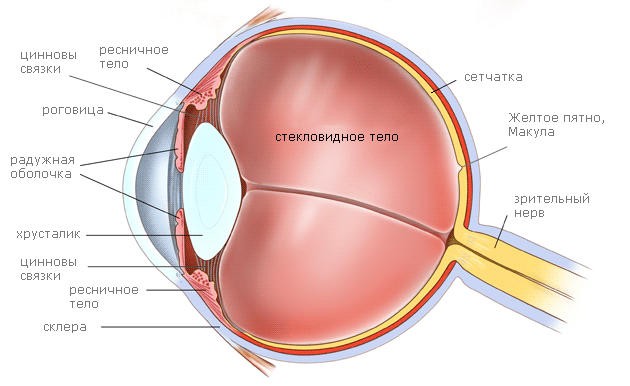
In 1 786, Felix Vic d'Azir , one of the founders of comparative anatomy, describes a blue spot, which, as it turns out centuries later, is activated in the REM phase . It is located in the brain stem and its axons ascend to the cerebral hemispheres. It is believed to be responsible for the reactions of anxiety, anxiety.
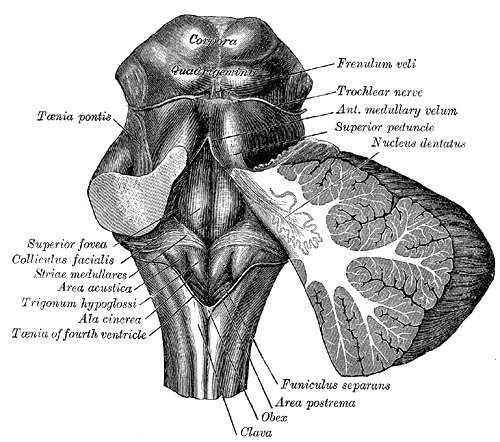
Johannes Ehrenritter in the year 1790 describes the glossopharyngeal nerve , which in the system of the cerebral cortex is listed under number IX. If his work is disturbed, the taste perception of the bitter worsens, swallowing is difficult.

One of the central figures in neurology of the late 18th century is Luigi Galvani, who, thanks to his experience with a dead frog , became the "father" of electrophysiology , and the term "galvanism" is still often used in a professional environment.
Currently, the electrostimulation of muscles demonstrated by Galvani is used in various fields from cosmetology to sports, and home muscle stimulants are extremely common.

In the future, some of Galvani's discoveries were refuted, but the impetus that his hypotheses gave was widely accepted with gratitude, because thanks to this there are now ECG studies, encephalography and others.
Toward the close of the century, some scientific works of Johann Christian Reil appear , who introduced the term “psychiatry” into science. His studies of the human brain, some of which occurred in the early 1800s, gave the world new ideas about the structure of the human brain. In particular, he described the islet of Rayle , which is responsible for motility and partly for taste buds, Rayleigh recess on the lower part of the cerebellum, triangle and much more.
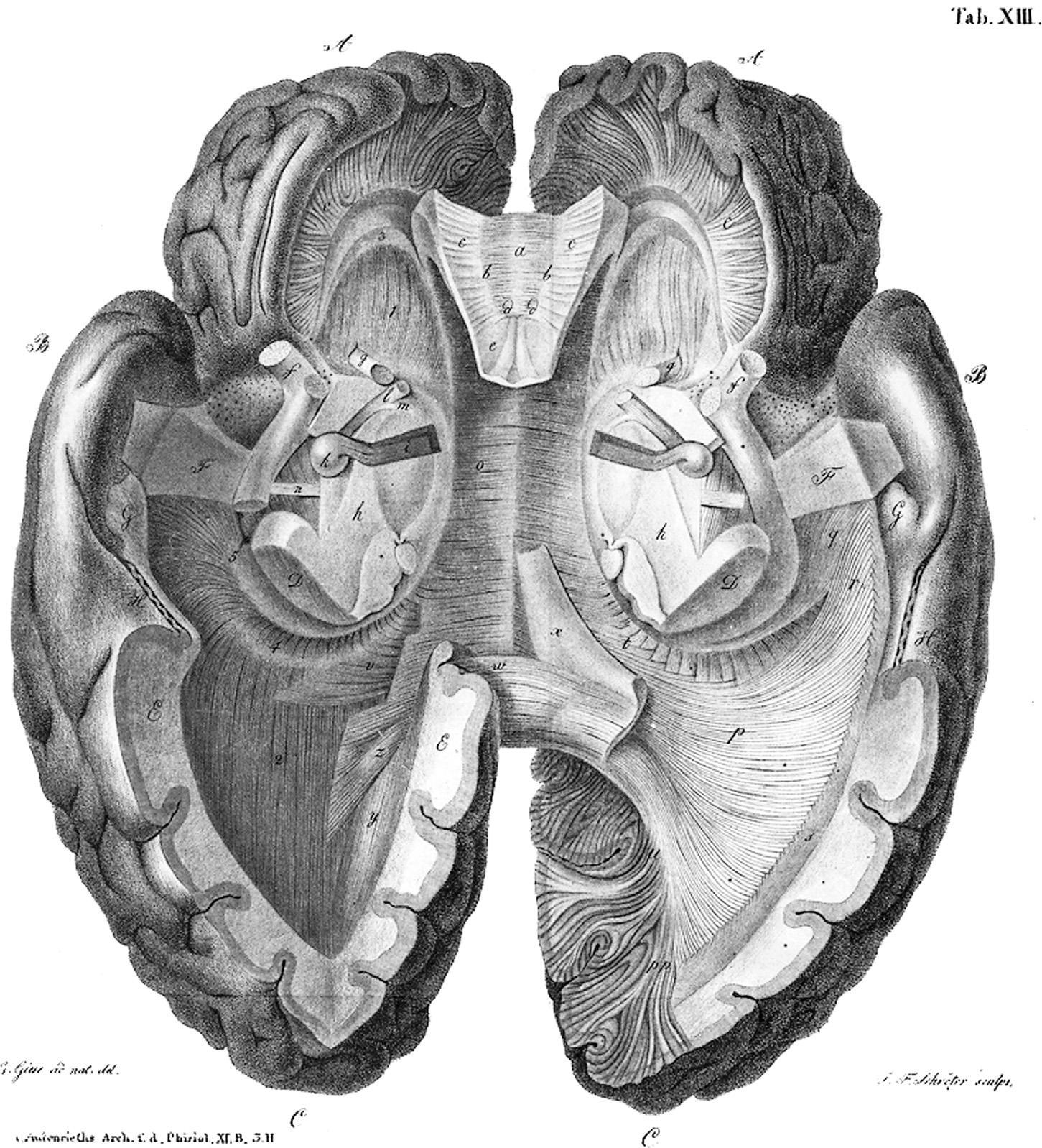
Rayle's drawing
In 1 794 - 1 798 years, John Dalton describes color blindness, which is still entrenched under the name " Color Blindness ".
At the very turn, in 1800, Samuel Thomas Semmering, already mentioned, describes the black substance of the brain, which is responsible for most of the most important functions necessary for life: respiration, cardiac activity, motor activity, eye movements ...
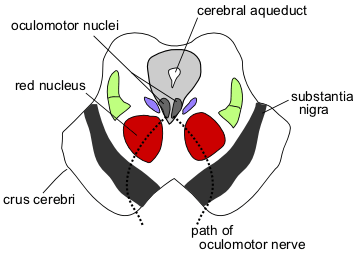
At the same time, some pseudoscience is also forming, one of which - phrenology - existed until the beginning of the 20th century. The founder of the theory is Franz Joseph Gal, who believed that the human psyche is due to the structure of his skull. It was later proved that the shape of the brain is not identical to the shape of the skull, and its relief cannot explain the psychic features.
In 1 808, Luigi Rolando describes the central cerebral cortex, revealing in it the “elements” that will later be named after him: the Rolando fissure ( central sulcus ), the Rolandic cap, the Rolandic cortex, and others. He also opens one of the types of epilepsy .
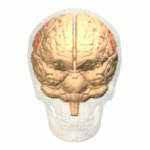
Central groove
The respiratory center in the medulla oblongata was discovered by the efforts of Julien le Galois in 1811. By the respiratory center is meant a set of neurons that generate a respiratory rhythm. After 70 years, work in this direction will continue the Russian scientist Mislavsky , who will also clarify the localization of this object.
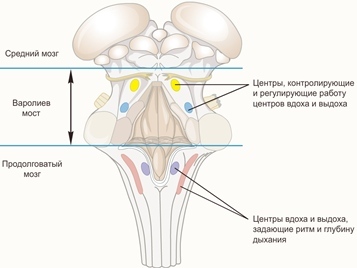
A double assessment of the activities of Benjamin Rush was given by contemporaries. Thus, some believed that he killed more patients than saved, which did not prevent him from entering the history of science as the " founder of American psychiatry ."
In 1813, Vic d'Azir discovered Claustrum, or the Fence, the finest part of the brain under the cerebral cortex. Her functions in the body are still disputed .
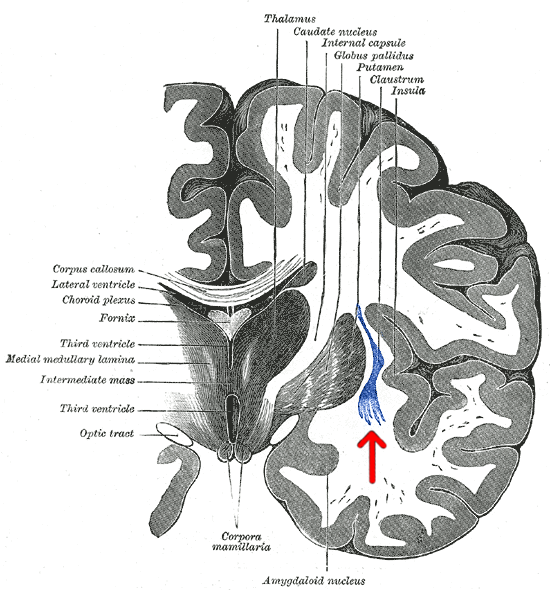
In 1 817, “Shivering Paralysis” was described, which received the name of its “discoverer” in the future — Parkinson's disease with characteristic symptoms in the form of tremor, muscle inelasticity, slow movement and difficulty breathing. The disease occurs when lesions of neurons of the substantia nigra of the brain and neurotransmitters of the central nervous system.
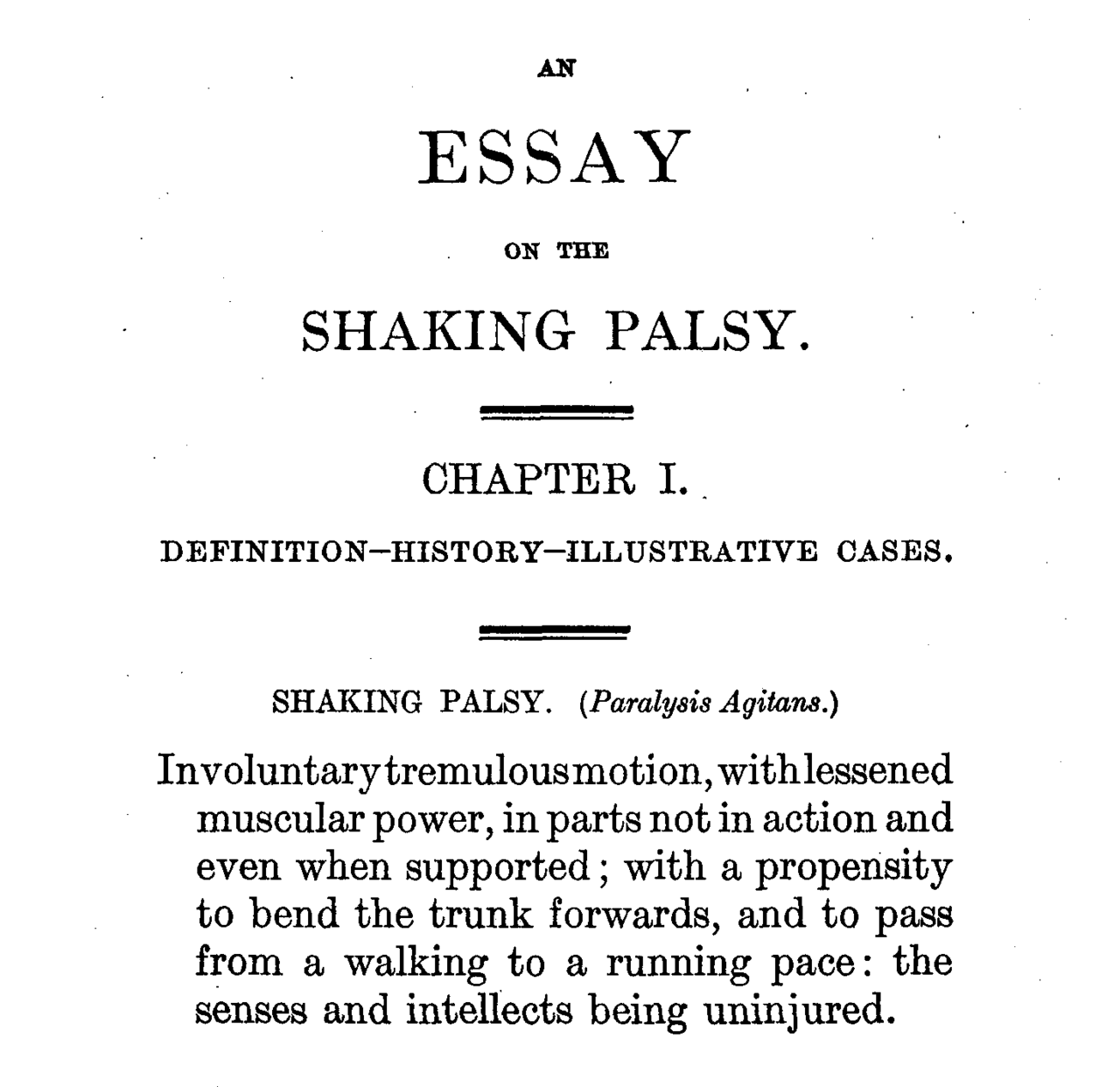
In 1 821, nerve palsy was first identified, named after Charles Bell. To this day, it remains one of the most common diseases, while it starts suddenly and the prerequisites are not fully defined.
In parallel with Bell, Magandy explores the nervous system. Also, the French physiologist described the opening of Magendie , or the medial opening of the brain, which connects the third and fourth ventricle.
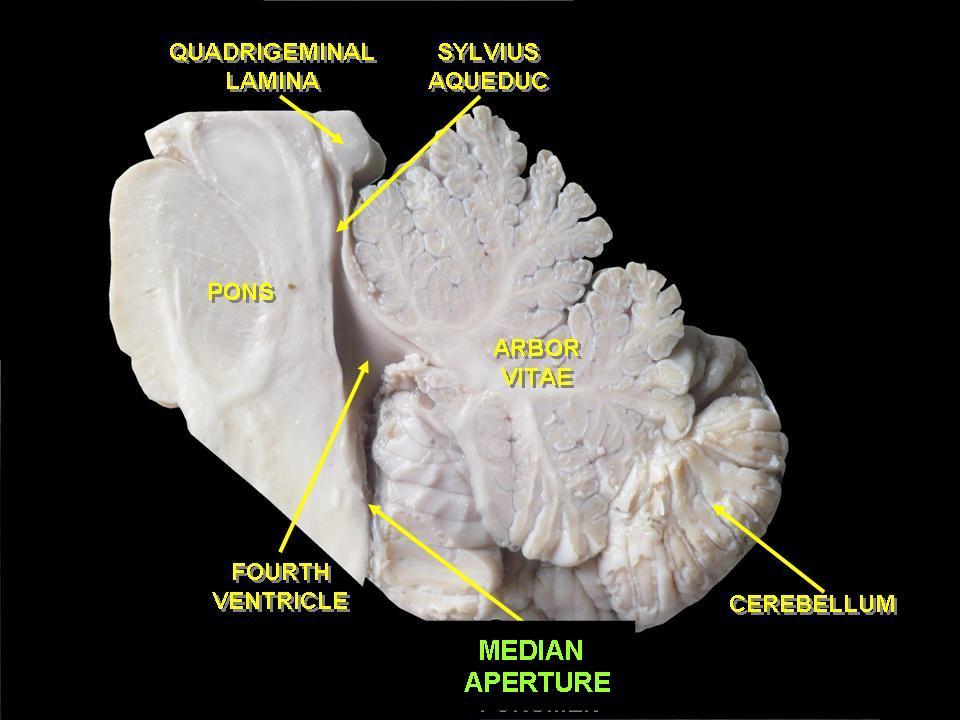
Median aperture, or the opening of Magendie
Around the same time, the work of Karl Burdah, who in 1822 points to the cingulate cortex , which is part of the limbic system and controls pain and emotional mood, and also participates in memory processes , dates back to about the same time .
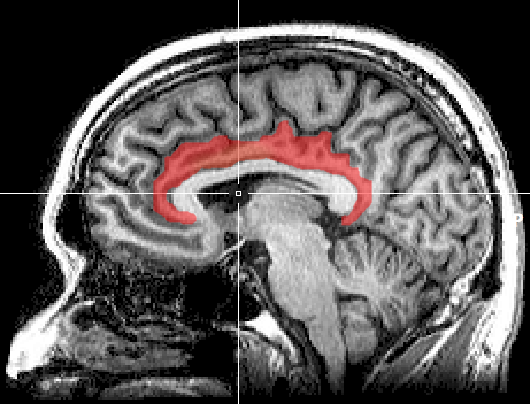
And a year later, in 1 823, Marie-Jean-Pierre Flurance empirically proves that the cerebellum is responsible for motor functions, and when it is removed, motor skills, movements, and coordination are catastrophically affected. In his studies in neurology and anatomy, the scientist will more accurately outline the functions of the medulla oblongata, proving that he is responsible for the functioning of the respiratory system.
In 1825, there were several discoveries at once. Jean-Baptiste Buyot localizes the functions of different parts of the brain and proves, in particular, that speech capabilities are directly related to the frontal lobe of the brain . In the same year, physiologist Robert Todd discusses the role of the cerebral cortex in the "generation" of emotions and the formation of thinking, describes the functionsstriatum . And the already mentioned Rolando describes the furrows separating the precentral and postcentral gyrus.

A year before his death, in 1836, Mark Dax was trying to explain the occurrence of aphasia, the discovery of which would later be attributed to Brock, and in science this form would be fixed to him . At the same time, and now disputes about whose name this form of speech impairment should bear continue . The discovery of Paul Brock happened thirty years later.

The discovery and description of neurons was made in 1836 by the German-Swiss physiologist Gabriel Gustav Valentin . At the same time, among his mentors was Johann the Evangelist Purkinje, who also studied nerve cells and fibers (Cell Purkinje fibers Purkinje), as well as the processes that they could excite the nervous system. He examined neurons in the cerebellum.
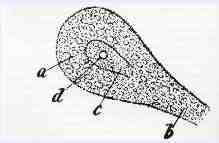
Neuron. Figure by Gabriel Gustav Valentine
During the same period, Remak describes myelinated and non-myelinated nerve fibers, shows the connection of fibers and nerve cells, and also proves that cells "multiply" by division.
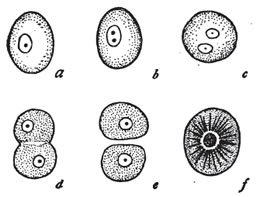
Myelin , which makes up the sheath of nerve fibers, will be described by Theodor Schwann, as well as the " Schwann cells " that make up the basis of the peripheral nervous system. And in 1839, he will propose his cellular theory .
In 1,840, Jules Beylergerconducts a number of studies in the field of sleep and hypnotic state, describes the phenomenon of hallucinations, but its main discovery is strips. He first noticed that the cerebral cortex is divided into 6 plates of gray and white matter. And in 1844, Remak sketched for the first time 6 layers of the cerebral cortex.

In the middle of the century, a momentous, though tragic, event takes place, which is well known to everyone. In 1848, Phineas Gage loses most of the frontal lobe of the left hemisphere due to the fact that his skull pierced through an iron rod.
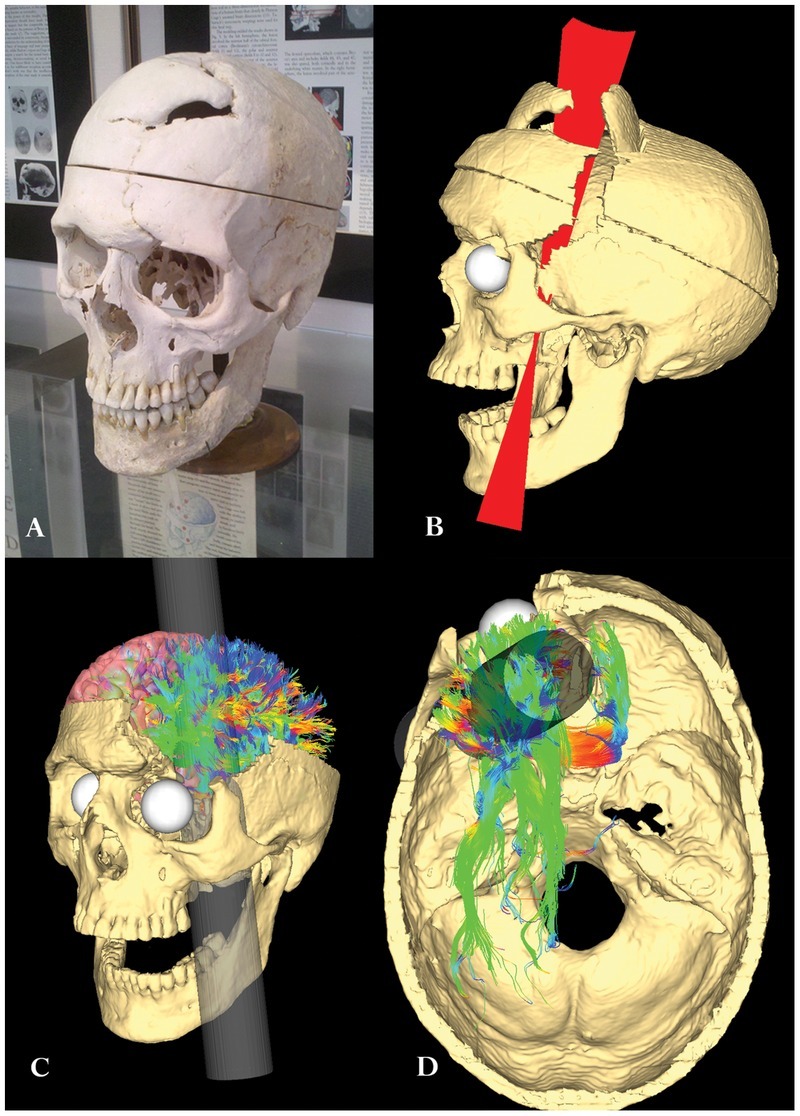
Despite serious damage, he quickly regained consciousness and after a couple of months was ready to start work again, however, as scientists note, irreparable damage to the body at the level of motor skills and psyche was nevertheless inflicted. Radical changes in habits, skills, and behavior in society were noted that even friends ceased to recognize the “former Gage” in him. Gage's injury served as an impetus for further study of the functions of the parts of the brain that do not stop to this day. One of the latest studies of this phenomenon was published several years ago .
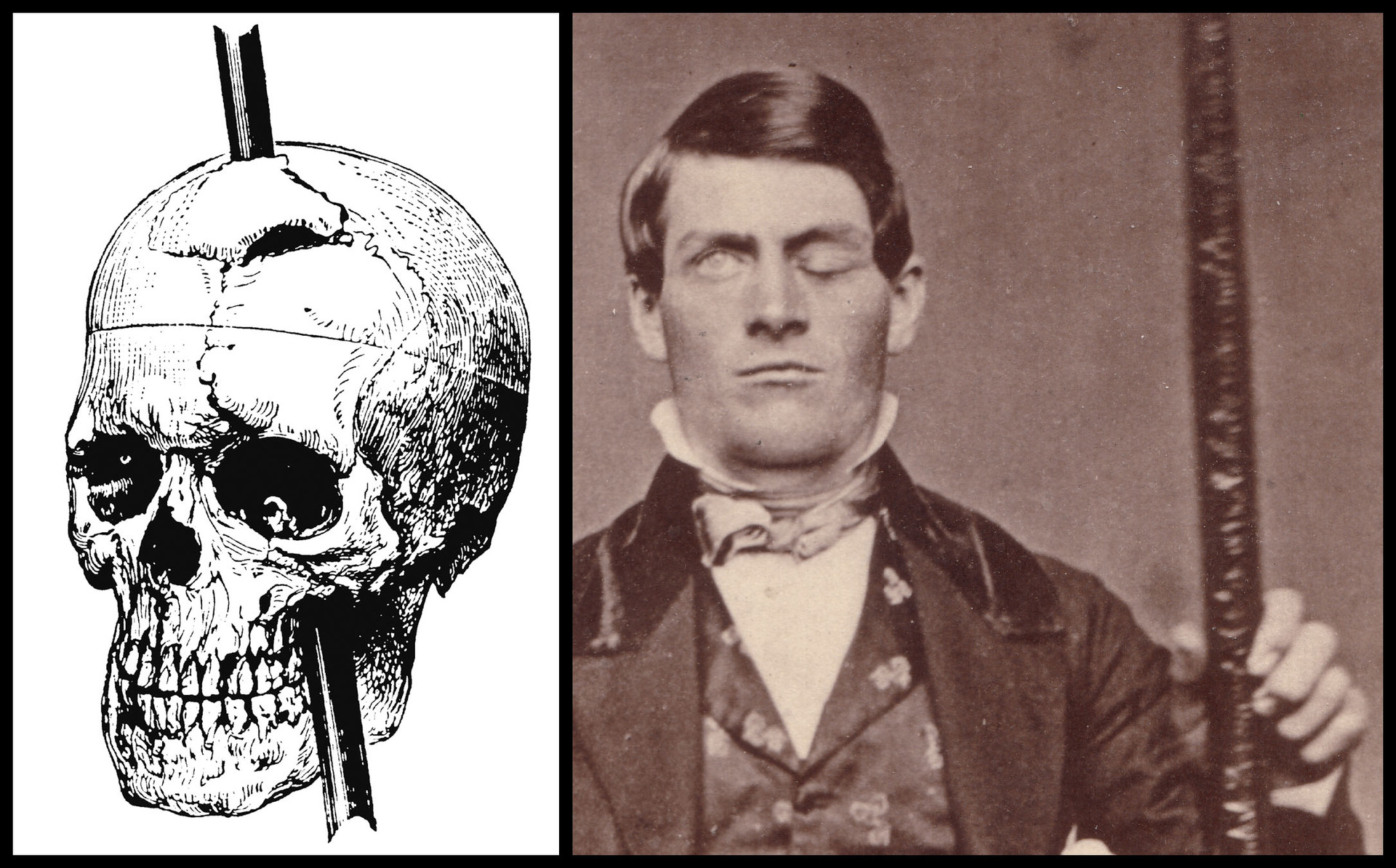
Since the mid-19th century, research has become more and more “targeted”, and scientists focus on individual organs, ophthalmology, and hearing organs are widely discussed. Neurology is interested in the spine and the nervous system as a whole, slightly “leaving” the human head. This period includes discoveries of nerve fiber degeneration , spinal shock , nuclei of the gray matter of the spinal cord, Heinrich Müller describes retinal cells , and his “colleague” Hermann von Helmholtz invents an ophthalmoscope.
At the same time, in 1 851, the Italian histologist Alfonso Corti was working, whose research in the field of the human auditory system made him famous and allowed him to talk about different methods of sound conduction, in particular bone conduction . The organ discovered by him and named in his honor Kortiev in the inner ear is the place where the analysis of sound signals begins.
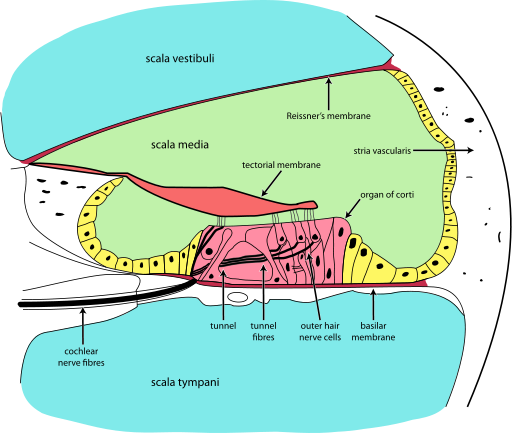
Andre Verga describes an anomaly called cavum vergae , which is not very widespread, as it were, the expansion of a transparent partition .

Physiologist William Carpenterin the middle of the century he developed the idea that reflexes originate not only in the spinal cord, but also in the brain, define the thalamus as a place where consciousness arises and for the first time indicates that alcoholism is a disease.
In 1 854, Louis Gratiola describes the meanders of the brain. Brock's main antagonist, Gratiola, believes that intelligence and reason are two different things, and the first can really be born in the brain. He draws his conclusions by comparing the brains of humans and animals, where from individual to individual the number of convolutions increases, which, in his opinion, indirectly indicates the stage of development of intelligence from lower to higher.
Among the “optical” discoveries, it is necessary to name the conclusions reached by Bartolomeo Panizza, who indicated that visual possibilities are contained in the posterior cerebral cortex. Now - the visual cortex . Richard Geschl finds the
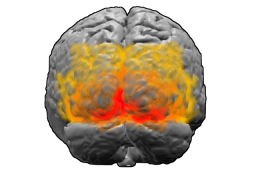
primary auditory cortex in the temporal lobe and describes the transverse gyrus, or Geshl's gyrus .
In 1885, one of the founders of the cellular theory, Rudolf Vikhrov, introduces and describes the term neuroglia , a collection of cells of the nervous tissue, studies of which continued in the future, in particular, Golgi was awarded the Nobel Prize precisely for discoveries in this part of the nervous system.
Karl Kalbaum describes a mental disorder that is later “included” in schizophrenia -cacatonic syndrome , manifestations of which are immunity to irritants, motor disorders.
In 1863, an outstanding Russian scientist Sechenov put forward the theory of reflexes that originate in the brain, and many of Sechenov's discoveries still bear his name. However, the contribution made to the Russian culture by the scientist must, of course, be discussed separately.
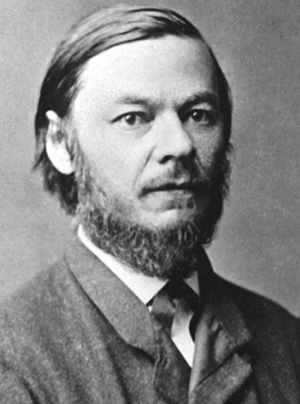
In the mid-1860s, the discoveries of the English neurologist Jackson John Hewlings , who owns research in the field of mental and neurological disorders, account for one of the forms of epilepsy that bears his name. Hewlings, however, reveals patterns between speech disorders and damage to individual parts of the brain, and also describes the motor centers of the cerebral cortex.
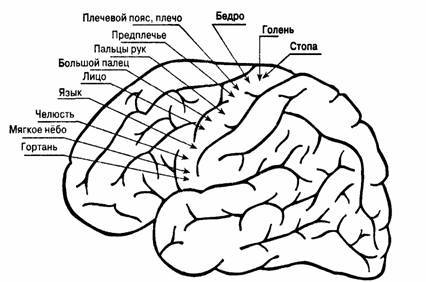
The five-year plan until the 1870s is characterized by refinements and generalizations of existing experience in various fields of neurology. Along with them, the concept of the lateral vestibular “Deuterium nucleus” appears , Down describes the syndrome of the same name, Bernstein discusses the potentials of rest and action in the nervous system, Theodor Meinert conducts microscopic studies of the cerebral cortex and gives an exhaustive description of the visual pathways, and Galton formulates the concept of eugenics . Ernst Bergman's classic textbook comes in 1,870about brain surgery and the treatment of brain diseases operatively. He also owns the idea of heat treatment of surgical instruments and sterilization of dressings, which will significantly improve the situation with infectious diseases after surgery.
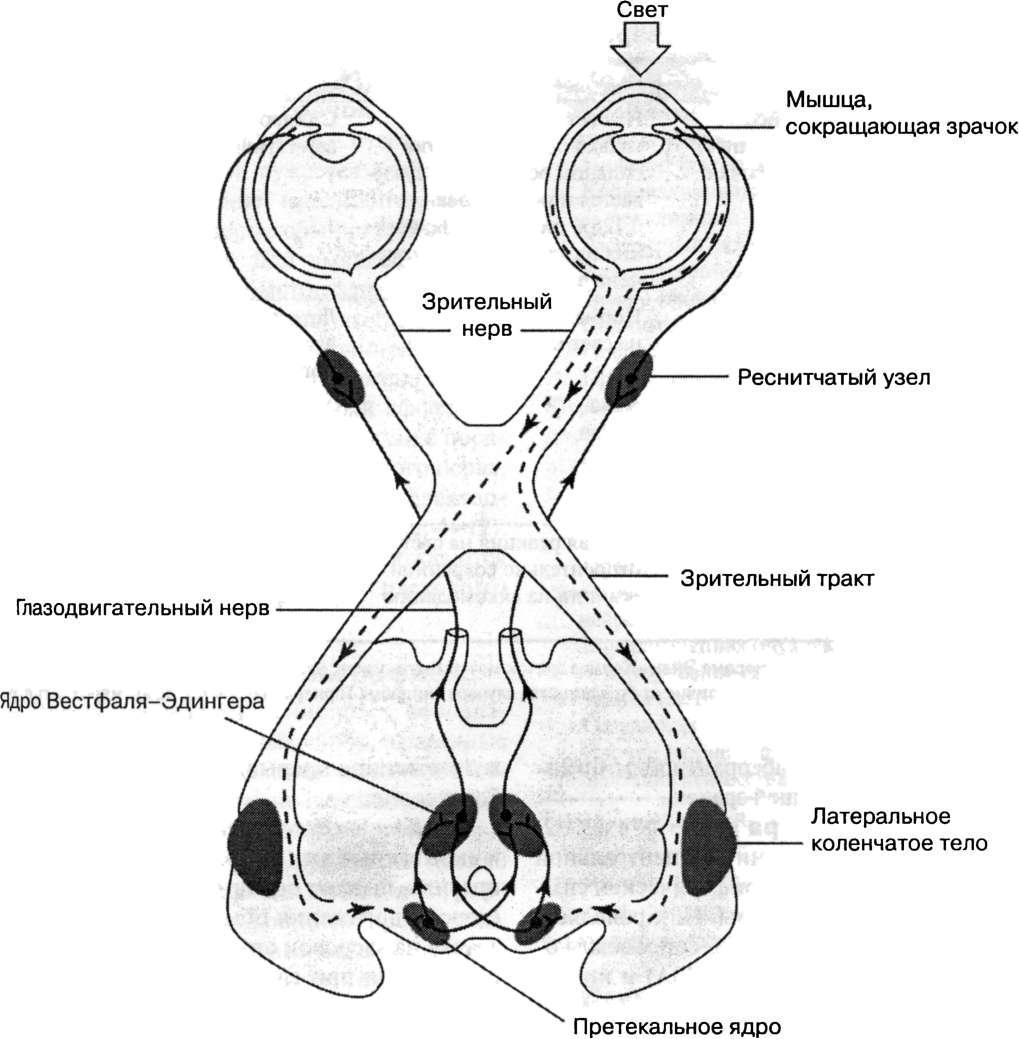
Until the end of the century, several important discoveries have been made. So, in 1872, the “ Inca Bone ” was described , in 1874, the first electrodes were used to stimulate the brain by Robert Bartolou, and in 1876, the academic work of David Ferrier, “ The functions of the brain, ” was performed . The flowering of “near-psychological” theories can be attributed to the same time, the most ambitious of which will go over into the novels of Emil Zola. Positivism is emerging, and some researchers, besides Comte, also call the name of Galton, who in the 1870s tries to explain his behavior and psychology through the environment and education of the individual.

The Inca bone
Wyven Bevan-Lewis continues to research the “ Betz cells ” discovered in 1874 by Vladimir Betz , a Kiev professor. It was he who first described the giant neurons in the cerebral cortex, which leave their axons to the muscles and can provoke involuntary movements.
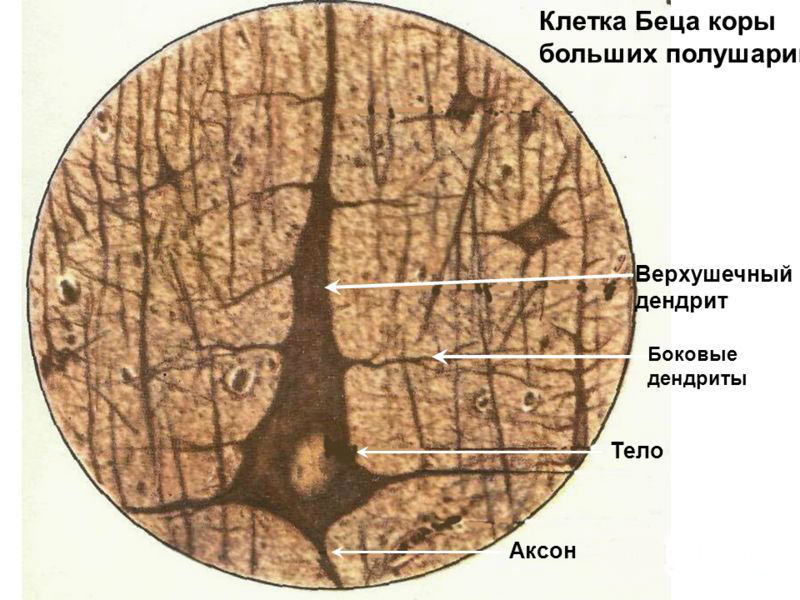
The first successful operation, under the direction of one of the founders of neurosurgery, William McEwan , was performed in the 1880s , as a result of which he managed to help the patient with an abscessbrain. The activities of McEwan played an important role in surgical art, and a number of pioneering, revolutionary techniques are listed behind it. For the first time, he operated on hernias and removed a lung.
At the same time, science began to work for the needs of secular society, and one of the “consumer” devices was the Dentaphone , a kind of bone conduction hearing aid, a patent for which was filed in 1880 by Thomas Greidon. This was one of those devices that could be used in theaters or at receptions, but at the same time it did not look like a special medical device.

Bone conduction in this case was transmitted through the teeth, from where the device got its name. Further bone conduction devicesgained incredible popularity, and in medicine - for many patients with hearing impairments - this has become almost the only way to hear, and today in the consumer electronics market . Among the bone-conduction technology headphones, the most cited item these days is Aftershokz Bluez2 .
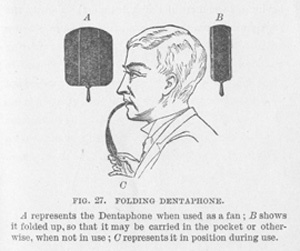
At the same time, Theodor Meinert continued his work and published a treatise on diseases of the forebrain. In 1883, Emil Kraepelin , who is called the founder of modern psychiatry, introduces and describes neurosis and psychosis, and in his works for the first time called manic depression and early dementia. In 1884, Georges Gilles de la Tourrett worked, which describes vocal and motor tics that are “combined” in the syndromeTurret.
In the same year, John Rickman Godley first removed a brain tumor by surgery. And three years later, Victor Gorsley does the same on the spinal cord.
In the final decade of the 19th century, animal experiments continued, the influence of psychology and semi-occult theories, hypnotic practices, etc., “exacerbated”. The activity of the Italian Cardiologist Luigi Luciani , which, among other things, made a number of important observations on the central nervous system , “exacerbated” . In particular, he belongs to the description of the functions of the cerebellum and the introduction of the concepts of asthenia, astasia, atony.
In 1895, the term hypothalamus was first established in science., which regulates the functions of the nervous and endocrine systems, providing homeostasis. True, the term homeostasis itself would be better not to name so far, since it will come into use at the end of the 20s of the next century, thanks to Walter Cannon .
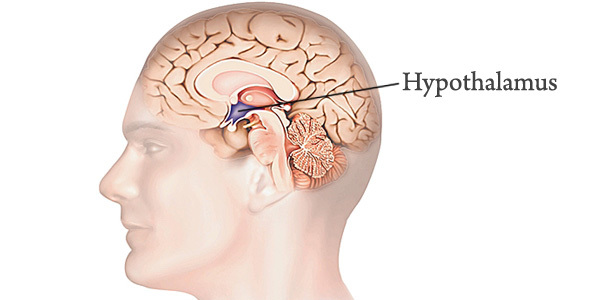
Toward the close of the century, an X-ray and an oscilloscope were invented , several painkillers were isolated, Bayer pharmacists began treating cough with heroin, cocaine is used as anesthesia on the spinal cord, and John Langley introduces the term autonomic ( autonomic ) nervous system.
The 20th century begins ...
The situation has become even more “complicated”, and research is becoming more and more deep, pointy, almost without metaphors - at the cellular level. And at the same time, the attempt continues to “unravel” the human psyche, emotional patterns and processes, feelings and thoughts, “tying” them to specific organs or parts of the nervous system.
The most prominent figure in the field of the study of consciousness and subconsciousness during this period was Sigmund Freud. Numerous theories in medicine and pedagogy give rise to the human psyche and the possibilities of influencing it, and not just exploring it, in particular, Alfred Binet’s work on adapting mentally retarded children and identifying patterns of intellectual disabilities is noteworthy .
The same attempts to study the processes in the brain include the work of Rorschach, the author of the test of the same name, the invention of the polygraph, first encephalography (EEG), which was demonstrated by Hans Berger in 1,928 .
In many ways, by the way, this procedure made possible the "round-the-clock" study of the activity of the human brain, and the first studies of the brain in a dream. In 1935, Bremer conducts the first experiments on cats, which give him some confirmation of his guesses about the "different" phases of sleep. However, Nathaniel Kleitman (Kleitman) will gain world fame in this field, who will not only give rise to somnology, but will also allow more attention to be taken to “ lucid dreams ”, the history of which I told in detail at Geektimes when I reviewed the Remee lucid dream mask.

All that will happen next is neuroscience, neuroscience and neurophysiology, as it were, of the “new time”, and you most likely know this better than us. Thanks for reading Medgadgets!

It is difficult to say how successful such surgical interventions were, but it is from this time, as it is believed, that the study of the human brain, psychology, neurology originates. Inside, as usual, there are many surnames, dates, links to the main discoveries and pictures of the human brain: Europe and the East, from Papyrus Edwin Smith to lucid dreams.

Ancient Chinese medicine is associated with a semi-mythical name - Shen Nong , who, in addition to determining a long-term herbal treatment, and according to legend, he “tested” them several times a day and self-poisoned, also warned the development of acupuncture, or acupuncture, which and to this day is common in China. The invention of reflexology dates back to approximately 2,700 BC, and today it is an intangible heritage of UNESCO .

Controversial Ancient Egypt. And this is not surprising in a country where medicine and science very closely coexisted with religion. On the one hand, the attitude to the brain was quite “cool,” and after death it was pulled out and frankly thrown out. Since the heart was considered the "central" organ, there are indications of this in "Ancient Egyptian Book of the Dead . "The heart is the key to the afterlife after weighing on the scales of good and evil.
On the other hand, the Edwin Smith Papyrus , named for the collector who bought the paper in 1862, is widely known . It was allegedly recorded in about 1,700 - 1,600 BC. At the moment, this is one of the main texts of ancient medical literature, in which a sufficient amount of information is devoted to head injuries, intracranial pulsations, interspersed, of course, with traditional spells against the plague, etc.

In total, on paper, the oral sources of which date from almost 3,000 to 2,500 BC. e. 48 “stories” are given, most of which relate to neurology, including open head and brain injuries. The first descriptions of cranial sutures, meninges and cerebrospinal fluids came with this document . The authorship is attributed to the founder of ancient Egyptian medicine, Imhotep , a very versatile person who served under Pharaoh Joser as an architect, and then went into medicine.

Hieroglyph “Brain”, approx. 1 700 BC e.
In parallel with this, approx. 2,000 BC e., scientists believe, in South America they continue to practice craniotomy as the prevention of headaches and mental illness, epilepsy. Moreover, a significant number of “opened” skulls indicates a systematic use of this “technology”.

Bronze “wedges” with sharp edges, presumably of volcanic rock, were used as a surgical instrument. However!
Some historians and archaeologists prefer to associate these prehistoric holes in their heads mostly with religion, since the first mention of epilepsy dates back to a much later time and a slightly different culture. Ancient Indian medicine, which began in Atharva Veda, gave the world approx. 6th century BC e. Sushruta Samhita is one of the main books of Ayurveda , where the foundations of surgery are laid.

One of the parts - Uttara - is dedicated to minor surgery, the so-called "shalakye", or surgery "above the shoulders", which provides descriptions and examples of ophthalmic diseases, including vascular diseases, and also refers to the removal of cataracts. An outfit with this text, the second most important treatise on medicine of that period - Charaka Samhita describes the mental disorders of people, considers epilepsy, its symptoms and treatment methods. Ayurveda books .
Hippocrates adhered to a similar point of view that epilepsy is a disease, not a divine punishment. The ancient Greek physician has a significant role in medical science, in particular the science of the brain, and it is he who is credited with the idea that the brain, the mind, originates in the brain. However, a century earlier , Alkmeon , a philosopher who was not mentioned anywhere, however, as a medical practitioner could have expressed the same idea . Despite this, he is credited with the discovery that the brain, and not the heart, is a key organ for a person that determines his life and destiny.
Other philosophers and theorists, however, quite great, also expressed hypotheses regarding the human brain, and Plato believed that the brain was the birthplace of all mental processes, and Aristotle, carried away by the science of sleep, assigned this role to the soul and heart. One way or another, without serious practice, studying the brain was impossible. A key legendary figure in ancient Greece was Erasiastes , a practicing physician, anatomist who described not only the brain departments and functions of the cerebellum, but also left at that time the only detailed description of the human circulatory system.
Erasiast works in tandem with the “Father of Anatomy” Herophilus , who clearly differentiated the brain and cerebellum, suggesting the functions of each. According to Herophilus, it is in the cerebellum that the “nucleation” of intelligence takes place.

Herophilus
Scientists steadily anatomize corpses, leaving us with detailed reports on the structure of the brain and heart, as well as a detailed description of the circulatory system. In the yard 335 - 280 BC, and these are the last major discoveries concerning the human brain for that period.

Cerebellum - Red
Roman Classics
Around the 177th year the work on the brain of the outstanding Roman surgeon Galen dates . His research included physiology, pharmacology, neurology, surgery, and many of the discoveries were confirmed during the Renaissance and today.
He owns the theory that since the cerebellum is harder relative to the brain, it is responsible for the muscles, and the brain itself - since it is softer - for the senses. He assigned the place of “one of the three souls” to the brain, and saw its origin in semen, as the substance was cold and wet.

It should be noted that since Roman law at the time of Galen’s activity prohibited the autopsy, most of his experiments took place on pigs and primates. Thanks to this, his descriptions of the trachea, circulatory system, which turned out to be very close to the human, appeared. Galen also owns the theory of "Body Juices" about human temperaments, or rather, their dependence on the amount of blood, bile and black bile and phlegm.
As in Ancient Greece, in Rome there was no shortage of philosophers, and one of them, Nemesia in workAbout 390, Nature of Man tries to describe the human body, taking into account already Christian traditions. He was not a doctor, but he assumed that various parts of the brain are responsible for various functions, and here, according to scientists, his task was not to describe the structure of the human brain, but to reconcile pre-Christian Platonic philosophy with the philosophy of modern times.
Medicine is also developing in the East, where translations including Greek books penetrate. One of the central monuments of medical literature is the Comprehensive Book on Medicine , the author of which, Abu Bakr Muhammad ibn Zakaria ar-Razi , was known both as a musician and as an artist, and by the age of 30 he became a passionate physician, leaving a legacy of his works in chemistry, pharmacology, medicine.

He first spoke of cranial nerves when he observed symptoms of meningitis, among which patients experienced severe dull headaches.
The second part of the book of Razi was devoted to eye diseases, and on the basis of this work, a century later, about 1,000 years, the works of Ammar ibn Ali Mosul, Alzachen and other prominent Islamic ophthalmologists of the Middle Ages appear .
In Europe, by this time, not the most successful times for brain research were coming, and for some medical manipulations one could easily be at the stake due to the church’s prohibitions on desecrating bodies. There are scammers who adapted to the emerging legends of the “Stone of Madness”, which allegedly provoked all mental disorders, and began to offer their services to “extract” this misfortune, which was widely reflected in the then and later painting.

Bruegel the Elder
One of the exceptions of the time is the Italian professor of medicine - Mondino de Lucci. The surgeon and the anatomist overcame church prohibitions and devoted much effort to returning the autopsy to the medical program, and in 1395 arranged a public sanction authorized by the Vatican.
The scientist insisted that man is a higher being, and the study of the structural features of his body is unacceptable on the example of animals, which ultimately "poured out" into the first professional anatomical text - "Anothomia", which gives a theory of brain bubbles . De Lucci believes that the three parts of the brain - the bubbles - give a person their abilities: the front - feelings, the middle - fantasies, the back - memory.

Dissection of the skull of de Lucci
Frankly speaking, de Lucci did not open the corpses very often, and most of his remarks were gleaned from the works of Galen, and the works themselves are an attempt to adapt to the European culture, which has experienced several centuries of overt decline, the work of Avicenna. Nevertheless, a new round of development of European medicine is associated with the name de Lucci. And European medicine continued to worry about diseases of the brain and psyche, as evidenced by the opening hospitals for the mentally ill. One of them is the one that has given us the common name Bedlam : the Bethlehem Royal Hospital.
Renaissance
The period of an unprecedented cultural upsurge in Europe has affected all spheres of human life from art to medicine. In 1,499 published by Johann Peyligk, where he possibly refers to an earlier work - Compendium philosophiae naturalis and examines the feelings and moods of man, which still borders on philosophy.

The primitive anatomy of Johann Peyligk
Anatomy is also devoted to some essays by Leonardo da Vinci, in particular the sketches of the ventricles, which in many respects corresponded to the descriptions of Galen.

The revolution in practical anatomy was made by Vesalius and his textbook Tabulae Anatomicae 1,538. The founder of “scientific” anatomy first sharply criticized Galen, who anatomized animals, and corrected over two hundred errors in the works of ancient physicians. In particular, he was ironic about the idea that “higher” brain functions are located in the ventricles, since the ventricles are also observed in animals, which means they cannot be responsible for emotions and feelings, as was supposed a long time before.
In 1,543, he published his main book, On the Structure of the Human Body , which is richly illustrated. It describes in detail the structure of the human brain, meninges, nerves, pituitary gland (in the terminology of Vesalius - glandula pituitaria).

A few years later, Vesalius for the first time will pay attention tohydrocephalus , dropsy of the brain, and describe its symptoms. According to legend, the inquisition will condemn the innovator of medicine to execution, and only the intercession of the king will save him, and then only half: Vesalius will be sent to exile, or a pilgrimage, from where he will not return.
In 1,549, a book by Jason Pratensis appeared on brain diseases and their symptoms, where he continues to develop Galen's work on the brain being “responsible” for motor functions. In his book De Cerebri Morbis, he describes tremors, tetanus, migraines, epilepsy, and also summarizes the experience of ancient and Arab authors regarding treatment. Despite the "secondary nature" of this text, some consider the first complete description of known brain diseases.
At the same time, Bratolomeo Eustachio, an antagonist of Vesalius, best known for his Eustachian tube, the part of the ear named in his honor, works. He owns many discoveries related to hearing, but his main book , published almost 200 years after his death, presents him as an outstanding anatomist. In the book, he left detailed descriptions of human organs, their sizes and locations, as they say, from head to toe.

His discoveries around the inner ear and middle ear, as well as his connection with the throat, determined not only the medical future. According to legend, it was the work of Eustachio that prompted one of the plot twists of Hamlet: poison that was poured into the ear of the father of the Danish prince.

Detailed engravings were prepared for the book, which saw the light after the death of the author, and one of them - XVIII - shows in sufficient detail the base of the brain and the division into the sympathetic and parasympathetic sections.
In 1,561, Gabriel Fallopio lists some cranial nerves, describes parts of the ear, and for the most part his anatomical works are devoted to the ear and skull, however, the uterine or fallopian tubes are named after him .
The discovery of the hippocampus in 1,564 belongs to the prominent Italian anatomist Giulio Cesare Aranzi (1,530 - 1,589), and this part of the limbic system of the brain has been called so since those times. The hippocampus is a paired structure located in the temporal sections and is responsible for the formation of emotions and long-term memory.

Aranzi’s student, Costanzo Varoly entered the history of medicine as the first who accurately described the mechanism of erection, and also introduced a new method of dissecting the brain, making it possible to examine it from the base. In the process of his work, he discovered in 1,573 a part of the hindbrain along with the cerebellum, which is responsible for the transfer of information from the spinal cord to the brain. This part of the brain now bears the name of the author - Varoliev Bridge .

De Nervis Opticis, Varolia the
16th century is coming to an end , and the last big name is Felix Platter , the founder of forensic medicine, who devoted a lot of time to the study of mental disorders. He belongs to the first classification of mental disorders, a description of psychoses andobsessive-compulsive disorder . I noticed and described intracranial tumors, in particular benign meningioma .

In 1 609, Giulio Casserio identifies the mammary bodies of the hypothalamus , located in the back, which are responsible for some behavioral factors. And at the same time, Robert Burton, a priest, philosopher and poet, writes The Anatomy of Melancholy , a prosaic book about depression. And I must say, if very rude, then starting from the 17th century, what the brain consists of and what happens in it, in simple terms, began to fall into “neurology”: in other words, everything that is connected with the head directly or indirectly.

1 641 years. The name of Francis Sylvia is associated with the discovery of the lateral groove of the brain, one of the deepest, which separates the temporal part from the parietal and frontal. And although for the first time in the drawings she was captured earlier, and the first who spoke about her - Caspar Bartolin - died by this time, it is Silvius who gives a detailed description.

Almost in the middle of the century, the central place in the brain - the Epiphysis, or pineal gland, attracted the attention of the philosopher Rene Descartes and gave her a place, "where the soul and all our thoughts originate." To date, the functions of the pineal gland are not fully understood , and the main ones include inhibition of growth hormones, inhibition of sexual development and the effect on sexual desire in general. Also, the thyroid gland is responsible for the production of melatonin.

The pineal gland in the illustration of Descartes
In 1 658, Johann Jacob Wepfer describes cerebrovascular disease and for the first time talks about what a stroke is and describes its symptoms and causes. His treatise on this is called Historiae apoplecticorum , and he is digitized.
One of the most important figures in the science of this century is Thomas Willis, who coined the term “Neurology”. He owns a number of important discoveries, in particular, the division of diabetes into “sweet as honey,” sugar and non-sugar, since he first drew attention to the taste of urine.
For the first time, it was he who numbered the cranial nerves, and this order is still used in clinical practice, and the Willis circle was also named after Willis- arterial circle at the base of the brain. A special role in his work was assigned to brain diseases, and Willis first spoke about the causes of epilepsy, convulsive diseases.

The Willis circle provides sufficient blood supply to the brain if there is a blockage of any vessels, and it is absolutely normally developed that it occurs only in 50% of cases. Most vascular aneurysms originate here.
In 1,664, the Dutch physician Gerard Vlasius discovered and described the arachnoid, or arachnoid membrane of the brain. This is one of three membranes, the middle one, covered on both sides by glial cells , which make up up to 40% of the central nervous system.

After 6 years, William Molins supplements the “picture” of the cranial nerves with a block, the deviation in which causes diplopia , or double vision.
Toward the close of the 17th century, several interesting studies appear at once. Some of them belong to the anatomist Raymond Wiessessens , who, inheriting the Willis tradition, gave a number of accurate, comprehensive descriptions of many modern ailments. The Semi-Oval Center is named after him - the white matter of the brain, which is located in each hemisphere and is located under the gray matter.

in 1 686, Thomas Sydenham , who owns the classic descriptions of many diseases, opens the choreaand describes her symptoms, indicating that her causes may be hidden in the brain. Later it became clear that in all cases of the disease, the basal nuclei located in the central white matter are affected . Chorea syndrome is accompanied by fanciful uncontrolled movements and can be either hereditary or acquired.
The rope-like body is opened by Humphrey Ridley , who is little known today , who left, however, many important notes. He practiced on hanged criminals, and was able to offer many new comments about the structure of the brain, the lymphatic system, even before Schlemm called the venous sinus of the sclera and made a description of the sarcoma. His main book was “Brain Anatomy”, where he first described the subarachnoid, or subarachnoid tanks (part of the structuresubarachnoid membrane ) filled with cerebral fluid. He also owns the discovery of the blood-brain barrier and the fifth cranial nerve.

And the 17th century ends philosophically - "The Experience of Human Understanding " by John Locke, where he discusses the theory of knowledge and the capabilities of the brain.

Neurology could not move on without equipment, and the time for anatomical discoveries that could be made with the naked eye passed. This was understandable in the middle of the past century, when thanks to Hooke , an optical microscope was improved .

Largely thanks to his discoveries of cells (in fact, the term “cell” itself belongs to Hook), science moved on. At the beginning of the 18th century, Antonio Pacquioni discovered Pacquion Granulation (named after him), focusing his research around the arachnoid membrane of the brain. And although today the functions of Pacquion granulations are not completely clear, the main hypothesis is based on the fact that they contribute to the outflow of cerebrospinal fluid into the venous channels of hard tissues and normalize in the hard shell of the brain.

Pakkionovskie granulation - 18
Despite the fact that the vast majority of the discoveries of Anthony van Levenguk were outside the scope of neurology and the 18th century, in 1 717 he describes nerve fibers. However, the contribution to the science of Levenguk, one of the founders of scientific micrography, inspired by his contemporary Robert Hook, is already huge, and E.-T.-A. Gofaman even made him the hero of one of his works.
In the same century, in one of David Gartley's books, the word "psychology" was first heard. In “Reflections on a Man, His Structure, His Duty, and Hopes,” the second part is devoted to theological issues, and in the first, Gartley discusses the nervous system of a person. But the scientist went down in history as a theorist of such a trend as associationism .
With the development of technology, the search begins for methods of treating various diseases. For example, the famous physicist, whose experiments with electricity served as the basis for subsequent discoveries, Jean-Baptiste le Roy , proposed to treat mental illness with the help of current, and conducted the first experiments in 1,755.
Impressive statements about the functions of the cerebellum in the year 1760 are made by Charles Lorry , noting that damage to this part of the brain destroys the coordination of movements, and also indicated which neck vertebrae need to be punctured so that death occurs instantly.
Largest Italian scientist Domenico Cutugno, who owns a number of discoveries in otolaryngology and neurology, notes the connection between the cerebrospinal fluid and the ventricles of the brain, however, it was done, it was apparently “like”, as the main work of the physician was turned to the back, and the discovery of some cerebrospinal fluid is attributed his. He also left a detailed description of the sciatic nerve.

At the same time, one of the representatives of the medical dynasty Alexander Monroe II was working , who would later describe the interventricular foramen, or the “ Monroe foramen ”, when closed, hydrocephalus may develop. It also provides normal circulation of cerebrospinal (cerebrospinal) fluid.
A detailed scientific description of cerebrospinal fluid in 1,766 will be left by Albrecht von Haller. His research in the field of the nervous and muscle systems allowed him to prove the reactions of the brain to various effects on the muscles, and he also demonstrated that when certain parts of the brain are removed, these reactions stop.

Haller. Icones anatomicae
In 1 773, the English physician John Fothergill describes the neuralgia of the triple nerve , which has long been called by his name. The disease is quite common and very painful, accompanied by wild shooting pains that relieve antiepileptic drugs or bone blockade.
Remedies for the human brain, chemical or “psychological,” also opened in the 18th century. In 1,773, Joseph Priestley discovered the “laughing gas," or nitric oxide, which is used as an inhalation anesthesia, and in 1774, Mesmer discovered "animal magnetism", a form of hypnosis that is not currently used in medicine.

In 1,776, Vincenzo Malacarne was engaged in research on the cerebellum and central nervous system, which determined the direction of research of many future classics of neurology. He was the first to fully describe the cerebellum anatomy correctly.
Malacarne is not the only one who generalizes and improves the experience of his predecessors. So, two years later, Samuel Thomas Semmering describes the classification of 12 cranial nerves, which is still relevant . The scientist at that time was 23 years old, and the classification became part of his thesis.

He will later describea retinal yellow spot , the studies of which are also “shared” by his contemporaries. The concept of " Gennari Strips " appears , Francesco Buzzi opens the thinnest place of the retina - the central fossa . In 1,781, the outstanding ophthalmologist Felice Fontana describes Ascon and the ascroplasma entering it.

In 1 786, Felix Vic d'Azir , one of the founders of comparative anatomy, describes a blue spot, which, as it turns out centuries later, is activated in the REM phase . It is located in the brain stem and its axons ascend to the cerebral hemispheres. It is believed to be responsible for the reactions of anxiety, anxiety.

Johannes Ehrenritter in the year 1790 describes the glossopharyngeal nerve , which in the system of the cerebral cortex is listed under number IX. If his work is disturbed, the taste perception of the bitter worsens, swallowing is difficult.

One of the central figures in neurology of the late 18th century is Luigi Galvani, who, thanks to his experience with a dead frog , became the "father" of electrophysiology , and the term "galvanism" is still often used in a professional environment.
Currently, the electrostimulation of muscles demonstrated by Galvani is used in various fields from cosmetology to sports, and home muscle stimulants are extremely common.

In the future, some of Galvani's discoveries were refuted, but the impetus that his hypotheses gave was widely accepted with gratitude, because thanks to this there are now ECG studies, encephalography and others.
Toward the close of the century, some scientific works of Johann Christian Reil appear , who introduced the term “psychiatry” into science. His studies of the human brain, some of which occurred in the early 1800s, gave the world new ideas about the structure of the human brain. In particular, he described the islet of Rayle , which is responsible for motility and partly for taste buds, Rayleigh recess on the lower part of the cerebellum, triangle and much more.
Rayle's drawing
In 1 794 - 1 798 years, John Dalton describes color blindness, which is still entrenched under the name " Color Blindness ".
At the very turn, in 1800, Samuel Thomas Semmering, already mentioned, describes the black substance of the brain, which is responsible for most of the most important functions necessary for life: respiration, cardiac activity, motor activity, eye movements ...

At the same time, some pseudoscience is also forming, one of which - phrenology - existed until the beginning of the 20th century. The founder of the theory is Franz Joseph Gal, who believed that the human psyche is due to the structure of his skull. It was later proved that the shape of the brain is not identical to the shape of the skull, and its relief cannot explain the psychic features.
In 1 808, Luigi Rolando describes the central cerebral cortex, revealing in it the “elements” that will later be named after him: the Rolando fissure ( central sulcus ), the Rolandic cap, the Rolandic cortex, and others. He also opens one of the types of epilepsy .

Central groove
The respiratory center in the medulla oblongata was discovered by the efforts of Julien le Galois in 1811. By the respiratory center is meant a set of neurons that generate a respiratory rhythm. After 70 years, work in this direction will continue the Russian scientist Mislavsky , who will also clarify the localization of this object.

A double assessment of the activities of Benjamin Rush was given by contemporaries. Thus, some believed that he killed more patients than saved, which did not prevent him from entering the history of science as the " founder of American psychiatry ."
In 1813, Vic d'Azir discovered Claustrum, or the Fence, the finest part of the brain under the cerebral cortex. Her functions in the body are still disputed .

In 1 817, “Shivering Paralysis” was described, which received the name of its “discoverer” in the future — Parkinson's disease with characteristic symptoms in the form of tremor, muscle inelasticity, slow movement and difficulty breathing. The disease occurs when lesions of neurons of the substantia nigra of the brain and neurotransmitters of the central nervous system.

In 1 821, nerve palsy was first identified, named after Charles Bell. To this day, it remains one of the most common diseases, while it starts suddenly and the prerequisites are not fully defined.
In parallel with Bell, Magandy explores the nervous system. Also, the French physiologist described the opening of Magendie , or the medial opening of the brain, which connects the third and fourth ventricle.
Median aperture, or the opening of Magendie
Around the same time, the work of Karl Burdah, who in 1822 points to the cingulate cortex , which is part of the limbic system and controls pain and emotional mood, and also participates in memory processes , dates back to about the same time .

And a year later, in 1 823, Marie-Jean-Pierre Flurance empirically proves that the cerebellum is responsible for motor functions, and when it is removed, motor skills, movements, and coordination are catastrophically affected. In his studies in neurology and anatomy, the scientist will more accurately outline the functions of the medulla oblongata, proving that he is responsible for the functioning of the respiratory system.
In 1825, there were several discoveries at once. Jean-Baptiste Buyot localizes the functions of different parts of the brain and proves, in particular, that speech capabilities are directly related to the frontal lobe of the brain . In the same year, physiologist Robert Todd discusses the role of the cerebral cortex in the "generation" of emotions and the formation of thinking, describes the functionsstriatum . And the already mentioned Rolando describes the furrows separating the precentral and postcentral gyrus.

A year before his death, in 1836, Mark Dax was trying to explain the occurrence of aphasia, the discovery of which would later be attributed to Brock, and in science this form would be fixed to him . At the same time, and now disputes about whose name this form of speech impairment should bear continue . The discovery of Paul Brock happened thirty years later.

The discovery and description of neurons was made in 1836 by the German-Swiss physiologist Gabriel Gustav Valentin . At the same time, among his mentors was Johann the Evangelist Purkinje, who also studied nerve cells and fibers (Cell Purkinje fibers Purkinje), as well as the processes that they could excite the nervous system. He examined neurons in the cerebellum.
Neuron. Figure by Gabriel Gustav Valentine
During the same period, Remak describes myelinated and non-myelinated nerve fibers, shows the connection of fibers and nerve cells, and also proves that cells "multiply" by division.

Myelin , which makes up the sheath of nerve fibers, will be described by Theodor Schwann, as well as the " Schwann cells " that make up the basis of the peripheral nervous system. And in 1839, he will propose his cellular theory .
In 1,840, Jules Beylergerconducts a number of studies in the field of sleep and hypnotic state, describes the phenomenon of hallucinations, but its main discovery is strips. He first noticed that the cerebral cortex is divided into 6 plates of gray and white matter. And in 1844, Remak sketched for the first time 6 layers of the cerebral cortex.

In the middle of the century, a momentous, though tragic, event takes place, which is well known to everyone. In 1848, Phineas Gage loses most of the frontal lobe of the left hemisphere due to the fact that his skull pierced through an iron rod.

Despite serious damage, he quickly regained consciousness and after a couple of months was ready to start work again, however, as scientists note, irreparable damage to the body at the level of motor skills and psyche was nevertheless inflicted. Radical changes in habits, skills, and behavior in society were noted that even friends ceased to recognize the “former Gage” in him. Gage's injury served as an impetus for further study of the functions of the parts of the brain that do not stop to this day. One of the latest studies of this phenomenon was published several years ago .

Since the mid-19th century, research has become more and more “targeted”, and scientists focus on individual organs, ophthalmology, and hearing organs are widely discussed. Neurology is interested in the spine and the nervous system as a whole, slightly “leaving” the human head. This period includes discoveries of nerve fiber degeneration , spinal shock , nuclei of the gray matter of the spinal cord, Heinrich Müller describes retinal cells , and his “colleague” Hermann von Helmholtz invents an ophthalmoscope.
At the same time, in 1 851, the Italian histologist Alfonso Corti was working, whose research in the field of the human auditory system made him famous and allowed him to talk about different methods of sound conduction, in particular bone conduction . The organ discovered by him and named in his honor Kortiev in the inner ear is the place where the analysis of sound signals begins.

Andre Verga describes an anomaly called cavum vergae , which is not very widespread, as it were, the expansion of a transparent partition .

Physiologist William Carpenterin the middle of the century he developed the idea that reflexes originate not only in the spinal cord, but also in the brain, define the thalamus as a place where consciousness arises and for the first time indicates that alcoholism is a disease.
In 1 854, Louis Gratiola describes the meanders of the brain. Brock's main antagonist, Gratiola, believes that intelligence and reason are two different things, and the first can really be born in the brain. He draws his conclusions by comparing the brains of humans and animals, where from individual to individual the number of convolutions increases, which, in his opinion, indirectly indicates the stage of development of intelligence from lower to higher.
Among the “optical” discoveries, it is necessary to name the conclusions reached by Bartolomeo Panizza, who indicated that visual possibilities are contained in the posterior cerebral cortex. Now - the visual cortex . Richard Geschl finds the

primary auditory cortex in the temporal lobe and describes the transverse gyrus, or Geshl's gyrus .
In 1885, one of the founders of the cellular theory, Rudolf Vikhrov, introduces and describes the term neuroglia , a collection of cells of the nervous tissue, studies of which continued in the future, in particular, Golgi was awarded the Nobel Prize precisely for discoveries in this part of the nervous system.
Karl Kalbaum describes a mental disorder that is later “included” in schizophrenia -cacatonic syndrome , manifestations of which are immunity to irritants, motor disorders.
In 1863, an outstanding Russian scientist Sechenov put forward the theory of reflexes that originate in the brain, and many of Sechenov's discoveries still bear his name. However, the contribution made to the Russian culture by the scientist must, of course, be discussed separately.

In the mid-1860s, the discoveries of the English neurologist Jackson John Hewlings , who owns research in the field of mental and neurological disorders, account for one of the forms of epilepsy that bears his name. Hewlings, however, reveals patterns between speech disorders and damage to individual parts of the brain, and also describes the motor centers of the cerebral cortex.

The five-year plan until the 1870s is characterized by refinements and generalizations of existing experience in various fields of neurology. Along with them, the concept of the lateral vestibular “Deuterium nucleus” appears , Down describes the syndrome of the same name, Bernstein discusses the potentials of rest and action in the nervous system, Theodor Meinert conducts microscopic studies of the cerebral cortex and gives an exhaustive description of the visual pathways, and Galton formulates the concept of eugenics . Ernst Bergman's classic textbook comes in 1,870about brain surgery and the treatment of brain diseases operatively. He also owns the idea of heat treatment of surgical instruments and sterilization of dressings, which will significantly improve the situation with infectious diseases after surgery.

Until the end of the century, several important discoveries have been made. So, in 1872, the “ Inca Bone ” was described , in 1874, the first electrodes were used to stimulate the brain by Robert Bartolou, and in 1876, the academic work of David Ferrier, “ The functions of the brain, ” was performed . The flowering of “near-psychological” theories can be attributed to the same time, the most ambitious of which will go over into the novels of Emil Zola. Positivism is emerging, and some researchers, besides Comte, also call the name of Galton, who in the 1870s tries to explain his behavior and psychology through the environment and education of the individual.

The Inca bone
Wyven Bevan-Lewis continues to research the “ Betz cells ” discovered in 1874 by Vladimir Betz , a Kiev professor. It was he who first described the giant neurons in the cerebral cortex, which leave their axons to the muscles and can provoke involuntary movements.

The first successful operation, under the direction of one of the founders of neurosurgery, William McEwan , was performed in the 1880s , as a result of which he managed to help the patient with an abscessbrain. The activities of McEwan played an important role in surgical art, and a number of pioneering, revolutionary techniques are listed behind it. For the first time, he operated on hernias and removed a lung.
At the same time, science began to work for the needs of secular society, and one of the “consumer” devices was the Dentaphone , a kind of bone conduction hearing aid, a patent for which was filed in 1880 by Thomas Greidon. This was one of those devices that could be used in theaters or at receptions, but at the same time it did not look like a special medical device.

Bone conduction in this case was transmitted through the teeth, from where the device got its name. Further bone conduction devicesgained incredible popularity, and in medicine - for many patients with hearing impairments - this has become almost the only way to hear, and today in the consumer electronics market . Among the bone-conduction technology headphones, the most cited item these days is Aftershokz Bluez2 .

At the same time, Theodor Meinert continued his work and published a treatise on diseases of the forebrain. In 1883, Emil Kraepelin , who is called the founder of modern psychiatry, introduces and describes neurosis and psychosis, and in his works for the first time called manic depression and early dementia. In 1884, Georges Gilles de la Tourrett worked, which describes vocal and motor tics that are “combined” in the syndromeTurret.
In the same year, John Rickman Godley first removed a brain tumor by surgery. And three years later, Victor Gorsley does the same on the spinal cord.
In the final decade of the 19th century, animal experiments continued, the influence of psychology and semi-occult theories, hypnotic practices, etc., “exacerbated”. The activity of the Italian Cardiologist Luigi Luciani , which, among other things, made a number of important observations on the central nervous system , “exacerbated” . In particular, he belongs to the description of the functions of the cerebellum and the introduction of the concepts of asthenia, astasia, atony.
In 1895, the term hypothalamus was first established in science., which regulates the functions of the nervous and endocrine systems, providing homeostasis. True, the term homeostasis itself would be better not to name so far, since it will come into use at the end of the 20s of the next century, thanks to Walter Cannon .

Toward the close of the century, an X-ray and an oscilloscope were invented , several painkillers were isolated, Bayer pharmacists began treating cough with heroin, cocaine is used as anesthesia on the spinal cord, and John Langley introduces the term autonomic ( autonomic ) nervous system.
The 20th century begins ...
The situation has become even more “complicated”, and research is becoming more and more deep, pointy, almost without metaphors - at the cellular level. And at the same time, the attempt continues to “unravel” the human psyche, emotional patterns and processes, feelings and thoughts, “tying” them to specific organs or parts of the nervous system.
The most prominent figure in the field of the study of consciousness and subconsciousness during this period was Sigmund Freud. Numerous theories in medicine and pedagogy give rise to the human psyche and the possibilities of influencing it, and not just exploring it, in particular, Alfred Binet’s work on adapting mentally retarded children and identifying patterns of intellectual disabilities is noteworthy .
The same attempts to study the processes in the brain include the work of Rorschach, the author of the test of the same name, the invention of the polygraph, first encephalography (EEG), which was demonstrated by Hans Berger in 1,928 .
In many ways, by the way, this procedure made possible the "round-the-clock" study of the activity of the human brain, and the first studies of the brain in a dream. In 1935, Bremer conducts the first experiments on cats, which give him some confirmation of his guesses about the "different" phases of sleep. However, Nathaniel Kleitman (Kleitman) will gain world fame in this field, who will not only give rise to somnology, but will also allow more attention to be taken to “ lucid dreams ”, the history of which I told in detail at Geektimes when I reviewed the Remee lucid dream mask.

All that will happen next is neuroscience, neuroscience and neurophysiology, as it were, of the “new time”, and you most likely know this better than us. Thanks for reading Medgadgets!
